Paul van Yperen's Blog, page 393
January 25, 2015
Noël-Noël
Noël-Noël (1897-1989) was a beloved French character actor and screenwriter. He appeared in 45 films between 1931 and 1966. His talents were diversified and he was known for his strong leftist political beliefs which seeped into many of his film scripts.
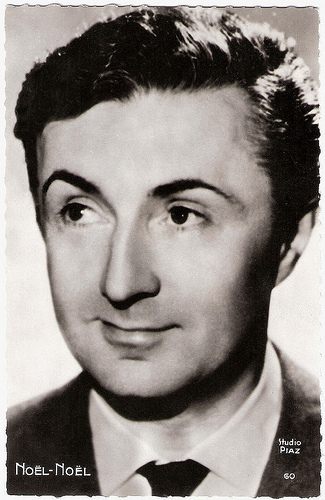
French postcard by Editions P.I., Paris, no. 60. Photo: Studio Piaz.
A blundering, chronically confused soldier
Noël-Noël was born Lucien Édouard Noël in Paris in 1897. He was the son of Charles Celestin Noël, a wine merchant (then employed at the Bank of France), and Marie Eugenie Mathieu. He studied at the Lycee Turgot and learned to play piano. From 1914 till 1917, he was a trainee at the Bank of France, before he left for military service and was mobilized.
After the war, he became a cartoonist for the magazine Le Canard enchaîné and the leftist newspaper l’Humanité. From 1920 on, he started to perform as singer. He made his stage debut at the music hall Noctambules, accompanying himself at the piano.
He also was a skillful songwriter. He participated in the revues of the Théâtre de Dix-Heures: Ah! La bonne heure (1927) and C'est l'heure exquise (1928). He continued to write and to compose songs, which he recorded for Odéon.
With a lead role in the comedy La Prison en folie/Prison Madness (Henry Wulschleger, 1930), he began an acting career in film. He appeared in such films as the drama Mistigri (Harry Lachman, 1931) opposite Madeleine Renaud , the comedy Monsieur Albert/Mister Albert (Karl Anton, 1932) with Betty Stockfeld, L'Innocent/Bouquets from Nicholas (Maurice Cammage, 1937), which he also co-wrote, and Sur le Plancher des vaches/On solid ground (Pierre-Jean Ducis, 1940) for which he solely wrote the scenario.
Noël-Noël became a star and he acted more rarely on stage. From October 1938 to the war, he hosted a show on Radio City with Saint-Granier . During the occupation of France, he continued to perform on stage. In 1943. he was banned by the Nazis after singing Vaches de boches.
In 1926, during his years in the music halls and cabarets, he had created the comic character Adémaï, a blundering, chronically confused soldier. Adémaï became the cunning victim of countless misadventures in a series of (short) films written by singer and writer Paul Coline: Adémaï et la Nation armée/Adémaï and the armed nation (Jean de Marguenat, 1932), Adémaï Joseph à l'O.N.M./Ademai Joseph at the Weather Tower (Jean de Marguenat, 1933), Adémaï aviateur/Skylark (Jean Tarride, 1934) with Fernandel , Adémaï au Moyen Âge/Adémaï in the Middle Ages (Jean de Marguenat, 1935) opposite Michel Simon , and Adémaï bandit d'honneur/Everything 'Appens to Me (Gilles Gragnier, 1943) with Georges Grey .
In the last part of the series, Adémaï au poteau-frontière/Adémaï at the post-border (Paul Coline, 1949), the character is played by Paul Coline himself.
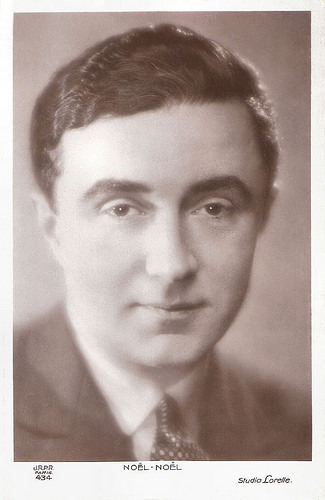
French postcard by J.R.P.R., Paris, no. 434. Photo: Studio Lorelle.
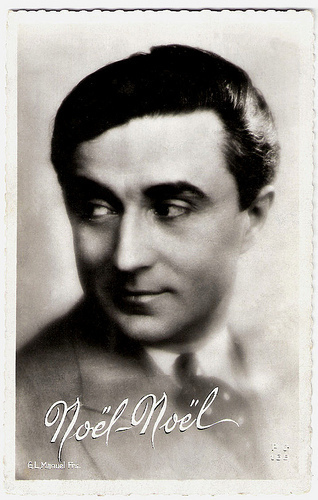
French postcard by Editions P.C., Paris, no. 168. Photo: G.L. Manuel Frères.
Mr. Orchid
In 1945, the year following the Liberation of France, Noël-Noël played the role of Matt Clement in La Cage aux rossignols/A Cage of Nightingales (Jean Dréville, 1945), for which he also participated on the script. Attracting an audience of over five million, it was the most popular French film to be seen in France in 1945. It was nominated for the Academy Award for Best Story and later inspired the successful comedy-drama Les Choristes/The Chorus (Christophe Barratier, 2004).
James Travers at French Films Site : “La Cage aux Rossignols is an engaging film that still has an impact. It effectively makes the point that children thrive better in an environment of mutual respect, where they are encouraged to develop their individual talents, rather than one in which they are brutalised and subjected to inflexible rules administered by unthinking automata with fascistic tendencies.”
Noël-Noël’s greatest role is probably the lead in the drama Le Père tranquille/Mr. Orchid (René Clément, 1946). He played an average, apparently selfish man mainly concerned with orchids, who actually is the leader of a network of the French Resistance.
Hal Erickson at AllMovie : “Droll French comedian Noel-Noel essays the title role in Le Pere Tranquille (The Quiet Daddy). Contrary to expectations, the star isn't a secret father, but in fact the unknown head of a WW2 resistance movement. By playing the fool whenever the Nazis are around and about, Noel-Noel is able to conceal his double life and successfully carry out his various sabotage missions. This deft combination of comedy and melodrama builds to a particularly suspenseful climax.”
This film, which was entered in the competition of the Cannes Film Festival allowed Noël-Noël to abandon comic roles for a while, but soon he returned with Les Casse-pieds/The Spice of Life (Jean Dréville, 1948). In 1950, he directed the musical La Vie chantée/Life in a Song, in which he performs many of his hits.
Among his popular successes is also the film À Pied, à cheval et en voiture/On Foot, horse and on wheels (Maurice Delbez, 1957) with Denise Grey, which was followed by À Pied, à cheval et en spoutnik/Hold Tight for the Satellite (Jean Dréville, 1958), for which Noël-Noël also worked on the scenario.
He played in Messieurs les ronds-de-cuir/The Bureaucrats (Henri Diamant-Berger, 1959) and in the entertaining comedy Les Vieux de la vieille/The Old Guard (Gilles Grangier, 1960) with Jean Gabin and Pierre Fresnay as a trio of irritable, temperamental grouchy men.
From then on, he gradually abandoned the screen. With Jean Dréville, he created the Science-Fiction TV Mini-Series Le Voyageur des siècles (1971), about a journey back in time. Then, Noël-Noël retired and lived in Nice in the South of France. There he died in 1989. He was 92.
He was married twice. In 1920, he married his first wife, Bertha Marie Genevieve Cornet. In 1930, he married Isabelle Jeanne Rosa Julie Lavallée.
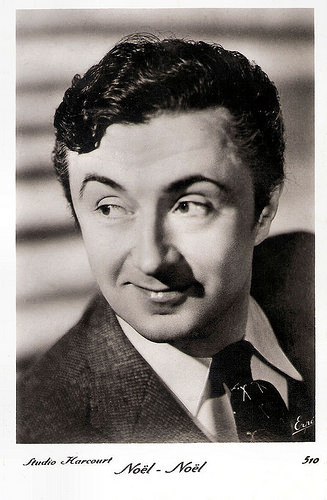
French postcard by Erpé, no. 510. Photo: Studio Harcourt.
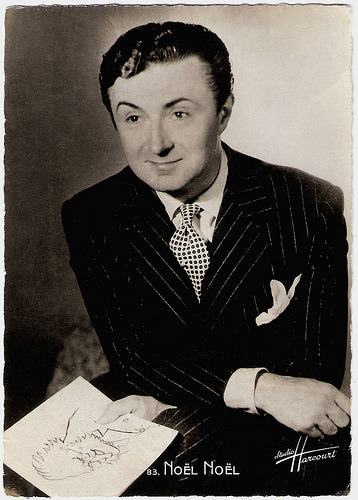
French postcard by S.E.R.P., Paris, no. 83. Photo: Studio Harcourt.
Sources: James Travers (French Films Guide), Hal Erickson (AllMovie), (IMDb), AllMovie, Wikipedia (French and English), and .

French postcard by Editions P.I., Paris, no. 60. Photo: Studio Piaz.
A blundering, chronically confused soldier
Noël-Noël was born Lucien Édouard Noël in Paris in 1897. He was the son of Charles Celestin Noël, a wine merchant (then employed at the Bank of France), and Marie Eugenie Mathieu. He studied at the Lycee Turgot and learned to play piano. From 1914 till 1917, he was a trainee at the Bank of France, before he left for military service and was mobilized.
After the war, he became a cartoonist for the magazine Le Canard enchaîné and the leftist newspaper l’Humanité. From 1920 on, he started to perform as singer. He made his stage debut at the music hall Noctambules, accompanying himself at the piano.
He also was a skillful songwriter. He participated in the revues of the Théâtre de Dix-Heures: Ah! La bonne heure (1927) and C'est l'heure exquise (1928). He continued to write and to compose songs, which he recorded for Odéon.
With a lead role in the comedy La Prison en folie/Prison Madness (Henry Wulschleger, 1930), he began an acting career in film. He appeared in such films as the drama Mistigri (Harry Lachman, 1931) opposite Madeleine Renaud , the comedy Monsieur Albert/Mister Albert (Karl Anton, 1932) with Betty Stockfeld, L'Innocent/Bouquets from Nicholas (Maurice Cammage, 1937), which he also co-wrote, and Sur le Plancher des vaches/On solid ground (Pierre-Jean Ducis, 1940) for which he solely wrote the scenario.
Noël-Noël became a star and he acted more rarely on stage. From October 1938 to the war, he hosted a show on Radio City with Saint-Granier . During the occupation of France, he continued to perform on stage. In 1943. he was banned by the Nazis after singing Vaches de boches.
In 1926, during his years in the music halls and cabarets, he had created the comic character Adémaï, a blundering, chronically confused soldier. Adémaï became the cunning victim of countless misadventures in a series of (short) films written by singer and writer Paul Coline: Adémaï et la Nation armée/Adémaï and the armed nation (Jean de Marguenat, 1932), Adémaï Joseph à l'O.N.M./Ademai Joseph at the Weather Tower (Jean de Marguenat, 1933), Adémaï aviateur/Skylark (Jean Tarride, 1934) with Fernandel , Adémaï au Moyen Âge/Adémaï in the Middle Ages (Jean de Marguenat, 1935) opposite Michel Simon , and Adémaï bandit d'honneur/Everything 'Appens to Me (Gilles Gragnier, 1943) with Georges Grey .
In the last part of the series, Adémaï au poteau-frontière/Adémaï at the post-border (Paul Coline, 1949), the character is played by Paul Coline himself.

French postcard by J.R.P.R., Paris, no. 434. Photo: Studio Lorelle.

French postcard by Editions P.C., Paris, no. 168. Photo: G.L. Manuel Frères.
Mr. Orchid
In 1945, the year following the Liberation of France, Noël-Noël played the role of Matt Clement in La Cage aux rossignols/A Cage of Nightingales (Jean Dréville, 1945), for which he also participated on the script. Attracting an audience of over five million, it was the most popular French film to be seen in France in 1945. It was nominated for the Academy Award for Best Story and later inspired the successful comedy-drama Les Choristes/The Chorus (Christophe Barratier, 2004).
James Travers at French Films Site : “La Cage aux Rossignols is an engaging film that still has an impact. It effectively makes the point that children thrive better in an environment of mutual respect, where they are encouraged to develop their individual talents, rather than one in which they are brutalised and subjected to inflexible rules administered by unthinking automata with fascistic tendencies.”
Noël-Noël’s greatest role is probably the lead in the drama Le Père tranquille/Mr. Orchid (René Clément, 1946). He played an average, apparently selfish man mainly concerned with orchids, who actually is the leader of a network of the French Resistance.
Hal Erickson at AllMovie : “Droll French comedian Noel-Noel essays the title role in Le Pere Tranquille (The Quiet Daddy). Contrary to expectations, the star isn't a secret father, but in fact the unknown head of a WW2 resistance movement. By playing the fool whenever the Nazis are around and about, Noel-Noel is able to conceal his double life and successfully carry out his various sabotage missions. This deft combination of comedy and melodrama builds to a particularly suspenseful climax.”
This film, which was entered in the competition of the Cannes Film Festival allowed Noël-Noël to abandon comic roles for a while, but soon he returned with Les Casse-pieds/The Spice of Life (Jean Dréville, 1948). In 1950, he directed the musical La Vie chantée/Life in a Song, in which he performs many of his hits.
Among his popular successes is also the film À Pied, à cheval et en voiture/On Foot, horse and on wheels (Maurice Delbez, 1957) with Denise Grey, which was followed by À Pied, à cheval et en spoutnik/Hold Tight for the Satellite (Jean Dréville, 1958), for which Noël-Noël also worked on the scenario.
He played in Messieurs les ronds-de-cuir/The Bureaucrats (Henri Diamant-Berger, 1959) and in the entertaining comedy Les Vieux de la vieille/The Old Guard (Gilles Grangier, 1960) with Jean Gabin and Pierre Fresnay as a trio of irritable, temperamental grouchy men.
From then on, he gradually abandoned the screen. With Jean Dréville, he created the Science-Fiction TV Mini-Series Le Voyageur des siècles (1971), about a journey back in time. Then, Noël-Noël retired and lived in Nice in the South of France. There he died in 1989. He was 92.
He was married twice. In 1920, he married his first wife, Bertha Marie Genevieve Cornet. In 1930, he married Isabelle Jeanne Rosa Julie Lavallée.

French postcard by Erpé, no. 510. Photo: Studio Harcourt.

French postcard by S.E.R.P., Paris, no. 83. Photo: Studio Harcourt.
Sources: James Travers (French Films Guide), Hal Erickson (AllMovie), (IMDb), AllMovie, Wikipedia (French and English), and .
Published on January 25, 2015 22:00
January 24, 2015
Tullio Carminati
Tullio Carminati (1892-1971) was an Italian stage and film actor with a long standing career from the 1910s to the 1960s. He played in Italian, German, American, British and French films as well as on Italian, American and British stages.
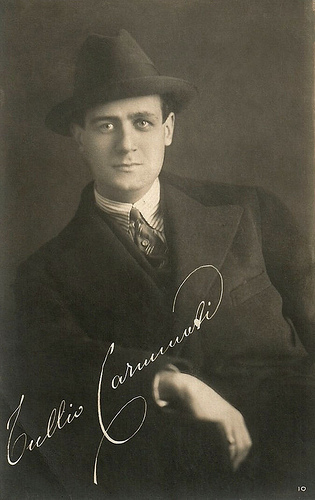
Italian postcard. Photo: Fotocolore, Torino.
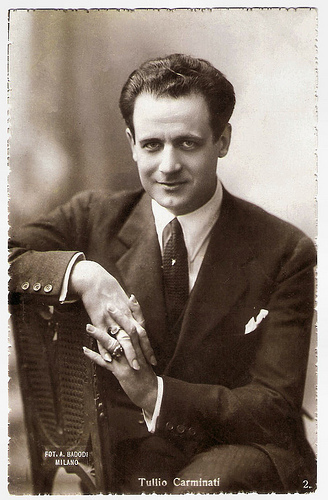
Italian postcard by Edizioni A. Traldi, Milano, no. 2. Photo: A. Badodi, Milano.
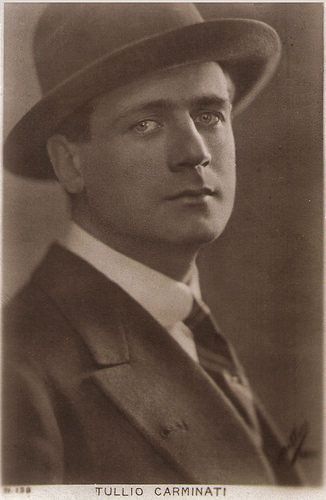
Italian postcard by Edizione Bettini, Roma, no. 128.
A modern, refined and sensible actor
Tullio Carminati was born as Count Tullio Carminati de Brambilla in Zara, Austrian-Hungarian Empire (now Zadar, Croatia) in 1892 (1894, according to IMDb and Wikipedia ).
He ran away from school and joined a theatre company which soon ran into financial trouble. Disinherited and chased from the house by his father, he had to start working as an actor. He managed to get employed by Alfredo de Sanctis in 1907, during a Dalmatian tour by the latter.
In 1909 Carminati arrived in Rome. By mediation of actor Gustavo Serena , Carminati met Ferruccio Garavaglia, first actor of the Compagnia stabile romana, which resided at the Teatro Argentina and which accepted him as an extra.
The company director, Ettore Paladini, was not convinced of Carminati’s talent and restricted him to modest parts. In 1910 actress Emma Grammatica discovered him, while giving guest performances at the Argentina. She admired his elegance and spontaneity and convinced the management to give him jeune premier parts.
Under this flag, star actor and director Ermete Novelli noticed him in La fiamma and hired him in 1912 for his own company. Novelli became his teacher who learned him to give a balanced and natural performance and the taste for simple and touching solutions. Under the aegis of Novelli, Carminati transformed in a modern, refined and sensible actor, free of affectations.
Soon, Marco Praga hired Carminati for his Compagnia stabile of the Teatro Manzoni in Milan and let him play in various modern plays by Gabriele D’Annunzio, Dario Niccodemi, Praga himself, and others. During a tour in South America and back in Milan the focus was more on the lighter repertory.
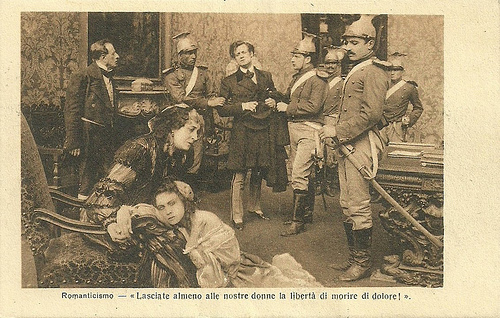
Italian postcard by IPACT, no. 742. Photo: Ambrosio. Count Vitaliano Lamberti (Tullio Carminati) is arrested by the Austrians, while his mother (Mary Cléo Tarlarini) and his wife (Helena Makowska) cannot help. Caption: 'Lasciate almeno delle nostre donne la libertà di morire di dolore' (At least permit our women the liberty to die of sorrow!).
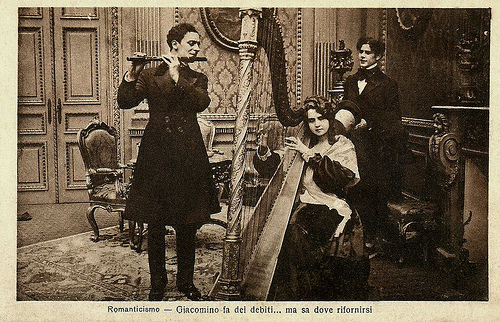
Italian postcard by IPACT, no. 747. Photo: Ambrosio. Helena Makowska (Anna Lamberti), Tullio Carminati (Count Vitaliano Lamberti) and Domenico Serra (Giacomino) in Romanticismo (Carlo Campogaliani, 1915). The caption: 'Giacomino fa dei debiti..., ma sa dove refonirsi' (Giacomino makes debts... but knows where to find funds to repay them).
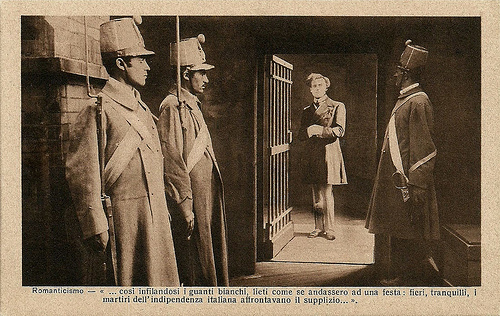
Italian postcard by IPACT, no. 752. Photo: Ambrosio. Tullio Carminati in Romanticismo (1915).
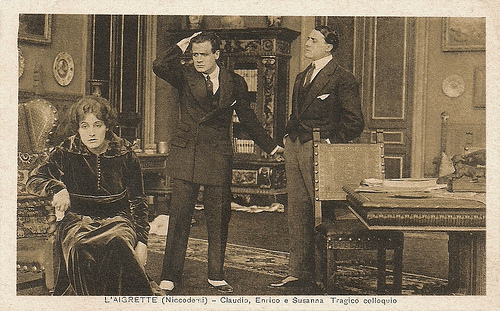
Italian postcard by IPA CT Duplex, no. 5108. Photo: Tiber Film. Hesperia, Tullio Carminati and André Habay in the Italian silent film L'aigrette (Baldassarre Negroni, 1917). Caption: 'Claudio, Enrico e Susanna. Tragico colloquio' (Claudio, Enrico and Susanna. Tragic conversation). The countess of Saint-Servant (Ida Carolini Talli) has raised her son Enrico (Tullio Carminati) to be proud of his name and title, and to cherish honour and virtue, symbolised by the feather of her aigrette. In reality the countess is hunted by creditors, the castle is falling apart. Enrico falls in love with Susanne Leblanc (Hesperia), wife of banker, and in return she loads him with money in order to restore the castle. Her husband Claudio (André Habay) is not so happy with this kind of charity...
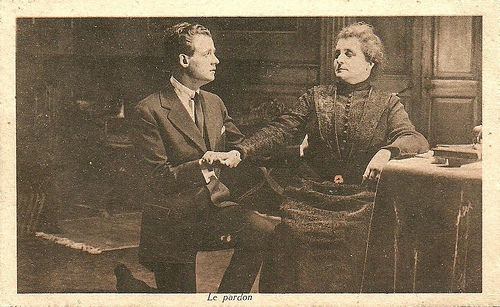
French postcard. Caption: 'Le pardon' (forgiveness). Photo: Tullio Carminati and Ida Carloni-Talli in the Italian silent film L'aigrette/The Egret (Baldassarre Negroni, 1917).
Eye For detail, realism and style
In 1914 Tullio Carminati made his début in the Italian silent cinema. His first film appearance was in La mia vita per la tua/My life for yours (1914), starring Maria Carmi and directed by Emilio Ghione .
When the Manzoni company stopped in 1915, Carminati signed a contract with the Ambrosio company of Turin, playing in the propaganda film Romanticismo/Romanticism (Carlo Campogalliani, Arrigo Frusta, 1915), in which he was the Italian aristocrat fighting the Austrians during the Risorgimento.
His co-actress was Elena Makowska who had her breakthrough in this film. Carminati would be paired with Makowska in several other Ambrosio films, as in Val d’Olivi/Val of Olives (Eleuterio Rodolfi, 1915), again set at the Risorgimento.
Carminati also did a few films with actress Madeleine Céliat , such as Davanti alla legge/In front of the law (Carlo Campogalliani, 1916).
In 1916 Carminati joined the theatre company of Lyda Borelli and Ugo Piperno. He played in Nozze dei Centauri (Wedding of the Centaurs), La donna nuda (The naked woman) and Amanti (Lovers).
But soon Carminati left again and focused on film acting, with titles like Tramonto triste/Sad Tramonte (Giuseppe Pinto, 1916) and L’articolo IV/The article IV (Gennaro Righelli, 1917). At the company Tiber Film, he played in a series of films directed by Augusto Genina in 1916-1918: Kalidaa – la storia una mummia/Kalidaa - the history of a mummy (1917), Il trono e la seggiola/The throne and the chair (1918) and in particular the successful films Il presagio/The premonition (1916) and La menzogna/The lie (1916), both with Vera Vergani .
By now Carminati had become a real film star, his face and shape endlessly reproduced on postcards, posters and photos, in particular his kiss from Il presagio. Between 1917 and 1922 Carminati acted in twelve star vehicles with the Italian diva Hesperia , such as L’aigrette/The Egret (1917), La donna dei cuori/The woman of the hearts (1917) and La donna abbandonata/The Abandoned Woman (1917), all directed by her husband Baldassarre Negroni.
In the late 1910s, Carminati also played with Maria Jacobini in La via più lunga/The longest street (Mario Caserini, 1918) and he made a few films with Gemma and Bianca Stagno Bellincioni.
In 1919 Carminati founded his own film company, Carminati-Film. He produced five films with it in 1919-1920, all directed by Enrico Roma, but in the end he was forced to dissolve the company. All in all Carminati played in some 37 Italian silent films between 1914 and 1924.
After some failures in the cinema Carminati was forced to return to the stage. There he became extremely successful with his own company, together with Alda Borelli , Lyda's sister, in 1920 and 1921.
Carminati’s plays were known for their eye for detail, realism and style and their lack of frivolous overdoing. He played elegant and refined characters, full of spirit and wit. However, his part as Armand in Alexandre Dumas’ La dame aux camélias (Camille) was considered as too cold.
When Borelli left the company in 1921, Carminati became director and first actor of Eleonora Duse ’s company. Here he directed three dramas of which he played only in one, Cosí sia (Such is) by T. Gallarati Scotti.
United Artists producer Joseph Schenck spotted him and offered him to come to Hollywood to play in a series of films, but after the failure of Carminati-Film and because of his workload at the theatre, Carminati had his doubts. When Duse went on tour to the US, Carminati joined the theatre company of Lucio d’Ambra and Mario Fumagalli, appearing in plays by Luigi Pirandello, Roberto Bracco and Sem Benelli.
Carminati did only a few films in those years including Mensch gegen Mensch/Person against person (Hans Steinhoff, 1923), shot in Germany with Alfred Abel in the lead.
Between 1924 and 1925 Carminati did a series of plays with Italia Almirante Manzini and Lina Tricerri, including the very successful comedy Le nozze di Leporello (The wedding of Leporello) by Luigi Almirante.
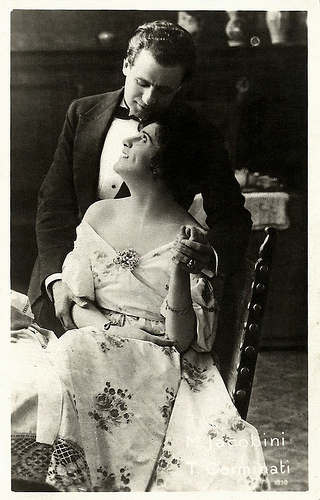
Italian postcard by Ed. Vettori, Bologna. Photo: probably a publicity still for L'articolo IV (Gennaro Righelli, 1918) with Maria Jacobini and Tullio Carminati.
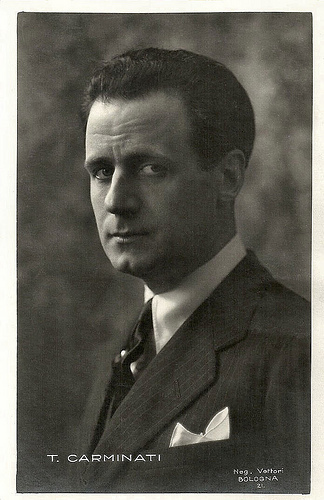
Italian postcard by Vettori, Bologna, no. 21.
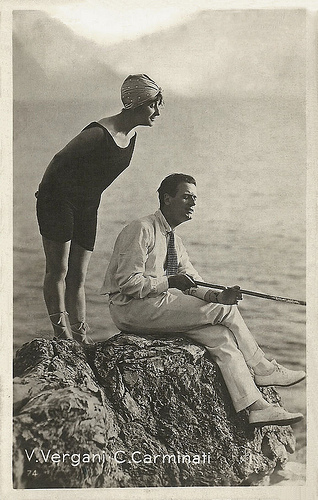
Italian postcard, no. 74. Sent by mail in 1924. At the company Tiber Film, Carminati played in a series of films directed by Augusto Genina in 1916-1918, in particular the successful films Il presagio (1916) and La menzogna (1916), both with Vera Vergani.
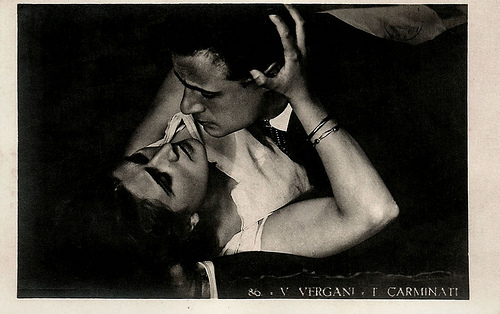
Italian postcard, no. 86. Photo: Carminati with Vera Vergani.
Elegance, Openness and Sobriety
Fed up with the decline of the Italian film world and deluded by the collaboration with Italia Almirante Manzini and Lina Tricerri, Tullio Carminati went to the US in 1925, without any clear prospects and without speaking the language properly.
After some time, he managed to get a contract with United Artists and played a detective in his first American film: The Bat (Roland West, 1926), with Jack Pickford and Louise Fazenda.
This was followed by parts as the 'lover' in The Duchess of Buffalo (Sydney Franklin, 1926) with Constance Talmadge, and Stage Madness (Victor Schertzinger, 1927) with Virginia Valli.
He then switched to Paramount where he reached fame with his part in Honeymoon Hate (Luther Reed, 1927) with Florence Vidor. He also acted in the Pola Negri vehicle Three Sinners (Rowland V. Lee, 1928).
With the advent of sound cinema, Carminati moved to New York and joined the company of Basil Rathbone. Critics liked his elegance, openness and sobriety, while audiences loved his foreign accent and Latin lover image. His American stage career was confirmed with Strictly Dishonorable by Preston Sturges, which ran for two years in 1930-1931 in some 725 shows. The continuous success of this play reopened the doors of Hollywood for Carminati.
Until 1940, he continued to play in various films, like Gallant Lady (Gregory LaCava, 1933), Moulin Rouge (Sydney Lanfield, 1934) with Constance Bennett, and One Night of Love (Victor Schertzinger, 1934) with Grace Moore.
In Europe he played the male lead in the Franco-Italian production Marcia nuziale/The Wedding March (Mario Bonnard, 1935), starring Kiki Palmer. After another Broadway show, he acted in the romantic comedies Let’s Live Tonight (Victor Schertzinger, 1934) with Lilian Harvey , and Paris in Spring (Lewis Milestone, 1935) with Mary Ellis, establishing him as the mature Don Giovanni.
In 1936 he acted in two British films by Herbert Wilcox: London Melody (1936) and The Three Maxims (1936), both starring Anna Neagle .
In 1938, after a stay in Italy, he played again on Broadway in By Candle Light, and in 1939 in the comedy Stephen Jumel. In 1940 he played in Hollywood in Sunset in Vienna (Norman Walker, 1940), with Lilli Palmer , and in Safari (Edward H. Griffith, 1940), with Douglas Fairbanks jr. and Madeleine Carroll .
In December 1941, a few days after the US declared war to Italy, Carminati was imprisoned. He was sent back to Italy in May 1942, because of anti-American activities.
In the following year he made his Italian cinema come-back in La via torna/The Street Turns (Pier Luigi Faraldo, 1943) and he joined the company of Elsa de Giorgi and Elena Zareschi, performing in various plays before and after the liberation there.
In 1946 he joined the company Morelli-Stoppa, for which he played in Antigone (Jean Anouilh), directed by Luchino Visconti.
In 1953, after a stage absence of several years, Carminati returned in such plays as Il Ferro (The Iron) by Gabriele D’Annunzio.
From the late 1940s until 1963, Carminati acted in various films in Italy, Spain, France and the US. Memorable titles are La Chartreuse de Parme/The Charterhouse of Parme (Christian Jaque, 1948) starring Gérard Philipe , La madonnina d’oro/The Golden Madonna (Ladislao Vajda, 1949) with Phyllis Calvert , La Beauté du diable/Beauty and the Devil (René Clair, 1950), the box office hit Roman Holiday (William Wyler, 1953) with Audrey Hepburn , Giovanna d’Arco al rogo/Joan of Arc at the Stake (Roberto Rossellini, 1954) with Ingrid Bergman , War and Peace (King Vidor, 1956), the epic El Cid (Anthony Mann, 1961) featuring Charlton Heston.
His final film was The Cardinal (Otto Preminger, 1963). Tullio Carminati died in 1971 in Rome because of a brain haemorrhage. He was 78.
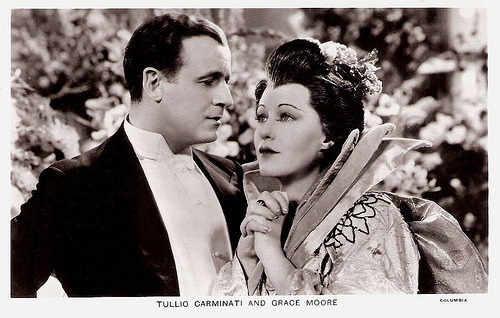
British postcard in the Film Partners Series, London, no. P 151. Photo: Columbia. Publicity still for One Night of Love (Victor Schertzinger, 1934).
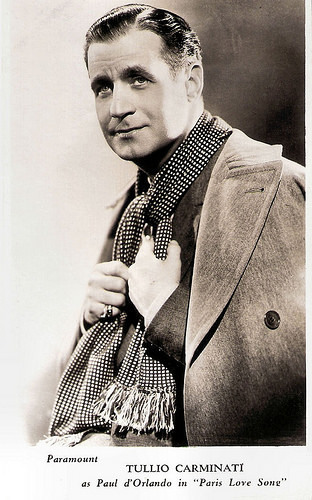
British postcard. Photo: Paramount. Publicity still for Paris in Spring/Paris Love Song (Lewis Milestone, 1935).
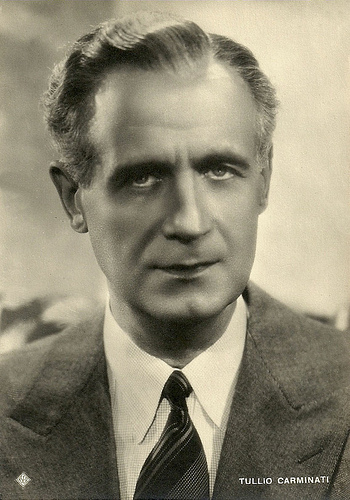
Italian postcard. Photo: Aser, Roma. Publicity still for La vita torna (Pier Luigi Faraldo, 1943) in which Carminati had the male lead.
Sources: Roberta Ascarelli (Italian - Treccani), Vittorio Martinelli (Italian - Il cinema muto italiano), Wikipedia (Italian and English), and . IMDb misspells and misdates quite a few of the Italian silent films of Carminati, and so does Wikipedia . Although both sites are invaluable sources for this blog, they are not infallible in their facts on European films. But to be honest, neither is EFSP :)

Italian postcard. Photo: Fotocolore, Torino.

Italian postcard by Edizioni A. Traldi, Milano, no. 2. Photo: A. Badodi, Milano.

Italian postcard by Edizione Bettini, Roma, no. 128.
A modern, refined and sensible actor
Tullio Carminati was born as Count Tullio Carminati de Brambilla in Zara, Austrian-Hungarian Empire (now Zadar, Croatia) in 1892 (1894, according to IMDb and Wikipedia ).
He ran away from school and joined a theatre company which soon ran into financial trouble. Disinherited and chased from the house by his father, he had to start working as an actor. He managed to get employed by Alfredo de Sanctis in 1907, during a Dalmatian tour by the latter.
In 1909 Carminati arrived in Rome. By mediation of actor Gustavo Serena , Carminati met Ferruccio Garavaglia, first actor of the Compagnia stabile romana, which resided at the Teatro Argentina and which accepted him as an extra.
The company director, Ettore Paladini, was not convinced of Carminati’s talent and restricted him to modest parts. In 1910 actress Emma Grammatica discovered him, while giving guest performances at the Argentina. She admired his elegance and spontaneity and convinced the management to give him jeune premier parts.
Under this flag, star actor and director Ermete Novelli noticed him in La fiamma and hired him in 1912 for his own company. Novelli became his teacher who learned him to give a balanced and natural performance and the taste for simple and touching solutions. Under the aegis of Novelli, Carminati transformed in a modern, refined and sensible actor, free of affectations.
Soon, Marco Praga hired Carminati for his Compagnia stabile of the Teatro Manzoni in Milan and let him play in various modern plays by Gabriele D’Annunzio, Dario Niccodemi, Praga himself, and others. During a tour in South America and back in Milan the focus was more on the lighter repertory.

Italian postcard by IPACT, no. 742. Photo: Ambrosio. Count Vitaliano Lamberti (Tullio Carminati) is arrested by the Austrians, while his mother (Mary Cléo Tarlarini) and his wife (Helena Makowska) cannot help. Caption: 'Lasciate almeno delle nostre donne la libertà di morire di dolore' (At least permit our women the liberty to die of sorrow!).

Italian postcard by IPACT, no. 747. Photo: Ambrosio. Helena Makowska (Anna Lamberti), Tullio Carminati (Count Vitaliano Lamberti) and Domenico Serra (Giacomino) in Romanticismo (Carlo Campogaliani, 1915). The caption: 'Giacomino fa dei debiti..., ma sa dove refonirsi' (Giacomino makes debts... but knows where to find funds to repay them).

Italian postcard by IPACT, no. 752. Photo: Ambrosio. Tullio Carminati in Romanticismo (1915).

Italian postcard by IPA CT Duplex, no. 5108. Photo: Tiber Film. Hesperia, Tullio Carminati and André Habay in the Italian silent film L'aigrette (Baldassarre Negroni, 1917). Caption: 'Claudio, Enrico e Susanna. Tragico colloquio' (Claudio, Enrico and Susanna. Tragic conversation). The countess of Saint-Servant (Ida Carolini Talli) has raised her son Enrico (Tullio Carminati) to be proud of his name and title, and to cherish honour and virtue, symbolised by the feather of her aigrette. In reality the countess is hunted by creditors, the castle is falling apart. Enrico falls in love with Susanne Leblanc (Hesperia), wife of banker, and in return she loads him with money in order to restore the castle. Her husband Claudio (André Habay) is not so happy with this kind of charity...

French postcard. Caption: 'Le pardon' (forgiveness). Photo: Tullio Carminati and Ida Carloni-Talli in the Italian silent film L'aigrette/The Egret (Baldassarre Negroni, 1917).
Eye For detail, realism and style
In 1914 Tullio Carminati made his début in the Italian silent cinema. His first film appearance was in La mia vita per la tua/My life for yours (1914), starring Maria Carmi and directed by Emilio Ghione .
When the Manzoni company stopped in 1915, Carminati signed a contract with the Ambrosio company of Turin, playing in the propaganda film Romanticismo/Romanticism (Carlo Campogalliani, Arrigo Frusta, 1915), in which he was the Italian aristocrat fighting the Austrians during the Risorgimento.
His co-actress was Elena Makowska who had her breakthrough in this film. Carminati would be paired with Makowska in several other Ambrosio films, as in Val d’Olivi/Val of Olives (Eleuterio Rodolfi, 1915), again set at the Risorgimento.
Carminati also did a few films with actress Madeleine Céliat , such as Davanti alla legge/In front of the law (Carlo Campogalliani, 1916).
In 1916 Carminati joined the theatre company of Lyda Borelli and Ugo Piperno. He played in Nozze dei Centauri (Wedding of the Centaurs), La donna nuda (The naked woman) and Amanti (Lovers).
But soon Carminati left again and focused on film acting, with titles like Tramonto triste/Sad Tramonte (Giuseppe Pinto, 1916) and L’articolo IV/The article IV (Gennaro Righelli, 1917). At the company Tiber Film, he played in a series of films directed by Augusto Genina in 1916-1918: Kalidaa – la storia una mummia/Kalidaa - the history of a mummy (1917), Il trono e la seggiola/The throne and the chair (1918) and in particular the successful films Il presagio/The premonition (1916) and La menzogna/The lie (1916), both with Vera Vergani .
By now Carminati had become a real film star, his face and shape endlessly reproduced on postcards, posters and photos, in particular his kiss from Il presagio. Between 1917 and 1922 Carminati acted in twelve star vehicles with the Italian diva Hesperia , such as L’aigrette/The Egret (1917), La donna dei cuori/The woman of the hearts (1917) and La donna abbandonata/The Abandoned Woman (1917), all directed by her husband Baldassarre Negroni.
In the late 1910s, Carminati also played with Maria Jacobini in La via più lunga/The longest street (Mario Caserini, 1918) and he made a few films with Gemma and Bianca Stagno Bellincioni.
In 1919 Carminati founded his own film company, Carminati-Film. He produced five films with it in 1919-1920, all directed by Enrico Roma, but in the end he was forced to dissolve the company. All in all Carminati played in some 37 Italian silent films between 1914 and 1924.
After some failures in the cinema Carminati was forced to return to the stage. There he became extremely successful with his own company, together with Alda Borelli , Lyda's sister, in 1920 and 1921.
Carminati’s plays were known for their eye for detail, realism and style and their lack of frivolous overdoing. He played elegant and refined characters, full of spirit and wit. However, his part as Armand in Alexandre Dumas’ La dame aux camélias (Camille) was considered as too cold.
When Borelli left the company in 1921, Carminati became director and first actor of Eleonora Duse ’s company. Here he directed three dramas of which he played only in one, Cosí sia (Such is) by T. Gallarati Scotti.
United Artists producer Joseph Schenck spotted him and offered him to come to Hollywood to play in a series of films, but after the failure of Carminati-Film and because of his workload at the theatre, Carminati had his doubts. When Duse went on tour to the US, Carminati joined the theatre company of Lucio d’Ambra and Mario Fumagalli, appearing in plays by Luigi Pirandello, Roberto Bracco and Sem Benelli.
Carminati did only a few films in those years including Mensch gegen Mensch/Person against person (Hans Steinhoff, 1923), shot in Germany with Alfred Abel in the lead.
Between 1924 and 1925 Carminati did a series of plays with Italia Almirante Manzini and Lina Tricerri, including the very successful comedy Le nozze di Leporello (The wedding of Leporello) by Luigi Almirante.

Italian postcard by Ed. Vettori, Bologna. Photo: probably a publicity still for L'articolo IV (Gennaro Righelli, 1918) with Maria Jacobini and Tullio Carminati.

Italian postcard by Vettori, Bologna, no. 21.

Italian postcard, no. 74. Sent by mail in 1924. At the company Tiber Film, Carminati played in a series of films directed by Augusto Genina in 1916-1918, in particular the successful films Il presagio (1916) and La menzogna (1916), both with Vera Vergani.

Italian postcard, no. 86. Photo: Carminati with Vera Vergani.
Elegance, Openness and Sobriety
Fed up with the decline of the Italian film world and deluded by the collaboration with Italia Almirante Manzini and Lina Tricerri, Tullio Carminati went to the US in 1925, without any clear prospects and without speaking the language properly.
After some time, he managed to get a contract with United Artists and played a detective in his first American film: The Bat (Roland West, 1926), with Jack Pickford and Louise Fazenda.
This was followed by parts as the 'lover' in The Duchess of Buffalo (Sydney Franklin, 1926) with Constance Talmadge, and Stage Madness (Victor Schertzinger, 1927) with Virginia Valli.
He then switched to Paramount where he reached fame with his part in Honeymoon Hate (Luther Reed, 1927) with Florence Vidor. He also acted in the Pola Negri vehicle Three Sinners (Rowland V. Lee, 1928).
With the advent of sound cinema, Carminati moved to New York and joined the company of Basil Rathbone. Critics liked his elegance, openness and sobriety, while audiences loved his foreign accent and Latin lover image. His American stage career was confirmed with Strictly Dishonorable by Preston Sturges, which ran for two years in 1930-1931 in some 725 shows. The continuous success of this play reopened the doors of Hollywood for Carminati.
Until 1940, he continued to play in various films, like Gallant Lady (Gregory LaCava, 1933), Moulin Rouge (Sydney Lanfield, 1934) with Constance Bennett, and One Night of Love (Victor Schertzinger, 1934) with Grace Moore.
In Europe he played the male lead in the Franco-Italian production Marcia nuziale/The Wedding March (Mario Bonnard, 1935), starring Kiki Palmer. After another Broadway show, he acted in the romantic comedies Let’s Live Tonight (Victor Schertzinger, 1934) with Lilian Harvey , and Paris in Spring (Lewis Milestone, 1935) with Mary Ellis, establishing him as the mature Don Giovanni.
In 1936 he acted in two British films by Herbert Wilcox: London Melody (1936) and The Three Maxims (1936), both starring Anna Neagle .
In 1938, after a stay in Italy, he played again on Broadway in By Candle Light, and in 1939 in the comedy Stephen Jumel. In 1940 he played in Hollywood in Sunset in Vienna (Norman Walker, 1940), with Lilli Palmer , and in Safari (Edward H. Griffith, 1940), with Douglas Fairbanks jr. and Madeleine Carroll .
In December 1941, a few days after the US declared war to Italy, Carminati was imprisoned. He was sent back to Italy in May 1942, because of anti-American activities.
In the following year he made his Italian cinema come-back in La via torna/The Street Turns (Pier Luigi Faraldo, 1943) and he joined the company of Elsa de Giorgi and Elena Zareschi, performing in various plays before and after the liberation there.
In 1946 he joined the company Morelli-Stoppa, for which he played in Antigone (Jean Anouilh), directed by Luchino Visconti.
In 1953, after a stage absence of several years, Carminati returned in such plays as Il Ferro (The Iron) by Gabriele D’Annunzio.
From the late 1940s until 1963, Carminati acted in various films in Italy, Spain, France and the US. Memorable titles are La Chartreuse de Parme/The Charterhouse of Parme (Christian Jaque, 1948) starring Gérard Philipe , La madonnina d’oro/The Golden Madonna (Ladislao Vajda, 1949) with Phyllis Calvert , La Beauté du diable/Beauty and the Devil (René Clair, 1950), the box office hit Roman Holiday (William Wyler, 1953) with Audrey Hepburn , Giovanna d’Arco al rogo/Joan of Arc at the Stake (Roberto Rossellini, 1954) with Ingrid Bergman , War and Peace (King Vidor, 1956), the epic El Cid (Anthony Mann, 1961) featuring Charlton Heston.
His final film was The Cardinal (Otto Preminger, 1963). Tullio Carminati died in 1971 in Rome because of a brain haemorrhage. He was 78.

British postcard in the Film Partners Series, London, no. P 151. Photo: Columbia. Publicity still for One Night of Love (Victor Schertzinger, 1934).

British postcard. Photo: Paramount. Publicity still for Paris in Spring/Paris Love Song (Lewis Milestone, 1935).

Italian postcard. Photo: Aser, Roma. Publicity still for La vita torna (Pier Luigi Faraldo, 1943) in which Carminati had the male lead.
Sources: Roberta Ascarelli (Italian - Treccani), Vittorio Martinelli (Italian - Il cinema muto italiano), Wikipedia (Italian and English), and . IMDb misspells and misdates quite a few of the Italian silent films of Carminati, and so does Wikipedia . Although both sites are invaluable sources for this blog, they are not infallible in their facts on European films. But to be honest, neither is EFSP :)
Published on January 24, 2015 22:00
January 23, 2015
Die Halbstarken (1956)
Most of the German films of the 1950s were musical comedies, sentimental dramas or Heimatfilms. An exception was the teen drama Die Halbstarken/Teenage Wolfpack (Georg Tressler, 1956) which brought dark alleys, petticoats, leather jackets, American cars, teenage sex and crime to the screen. Germany's first look on juvenile delinquency gave also a rare realistic view of life in a German city during the Wirschaftswunder era, the years of the economic miracle. The film became a cult hit all over Europe and two new stars were born, Horst Buchholz as the charismatic gang leader and Karin Baal as his 15-year old femme fatale.
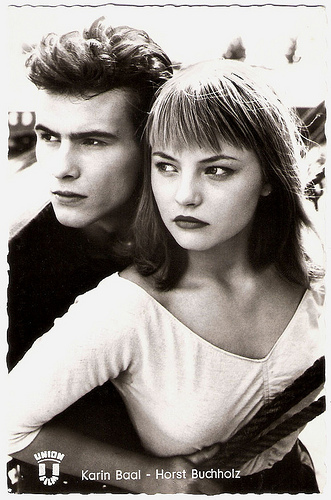
German postcard by Kolibri-Verlag, Minden/Westf., no. 2329. Photo: Interwest / Union / Haenchen. Publicity still for Die Halbstarken (1956).

Austrian postcard by Lichtbild-Vertrieb Paula Weizmann, Wien, no. F 7. Photo: Interwest / Union-Film / Haenchen. Publicity still for Die Halbstarken/Teenage Wolfpack (Georg Tressler, 1956).
Hard, raw and realistic
Young author Will Tremper did not like the sentimental films that were made in Germany and Austria during the 1950s. While German film makers produced cheesy Heimatfilms and family comedies, Hollywood presented energetic teen dramas as The Wild One (Laslo Benedek, 1953) with Marlon Brando, The Blackboard Jungle (Richard Brooks, 1955) and Rebel Without a Cause (Nicholas Ray, 1955), featuring James Dean.
In that vein, Tremper and director Georg Tressler decided to make a film that would become a classic of German post-war cinema.
With the exception of lead actor Horst Buchholz , they chose non-professionals to play the young gang members. Remarkable is also that the jukebox doesn't play the then new and hot rock & roll, but jazz music. Composer Martin Böttcher made the Soundtrack with Mister Martins Band.
The result was a sensation. According to Hal Erickson at AllMovie , the young actors are "exuding a raw energy that many 'pros' could not emulate.
For Volker Scheunert at IMDb , Die Halbstarken/Teenage Wolfpack (Georg Tressler, 1956) is his favourite German film of the 1950s: "This one is hard, raw and realistic, omitting any false sentimentality or romanticism."
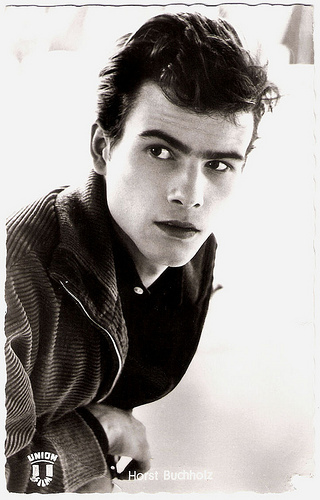
Horst Buchholz . German postcard by Kolibri-Verlag, Minden Westf., no. 2171. Photo: Interwest / Union-Film / Haenchen. Publicity still for Die Halbstarken/Teenage Wolfpack (Georg Tressler, 1956).
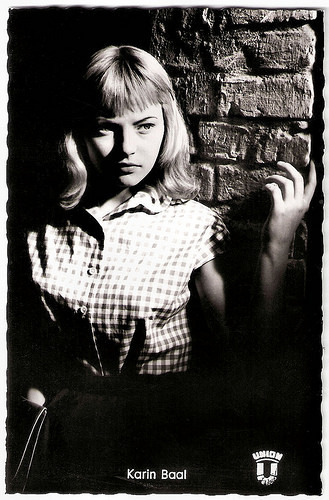
Karin Baal . German postcard by Kolibri-Verlag, Minden/Westf. Photo: Interwest / Union / Haenchen. Publicity still for Die Halbstarken (1956).
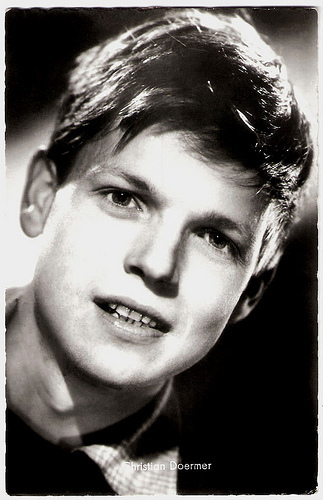
Christian Doermer . German postcard by Kolibri-Verlag, Minden-Westf., no. 140.
Dreaming of a Buick Cabriolet
Die Halbstarken - what can be translated as The Hooligans - was shot on location in West Berlin in 1955 and 1956.
Horst Buchholz plays 19-year old Freddy Borchert, who has been thrown out of his home by his overly strict father (Paul Wagner) and the charismatic but tough teenager has to survive on the streets of West-Berlin.
In an indoor swimming pool he meets his younger brother Jan ( Christian Doermer ). Freddy pretends to have a good job but he has risen to the head of a youth gang and leads a life of crime.
Jan knows that his parents need the huge sum of 3,000 Deutschmarks to pay their debts, and asks his brother if he could help them. Freddy says yes for his mother’s sake. He is preparing his 'biggest coup' ever: a mail car robbery that would not only allow him to help his parents but to fulfil his dream - buying a Buick Cabriolet.
But the robbery goes wrong. In order to reassert himself as the leader of the pack and to prove to his girlfriend Sissy ( Karin Baal ) that he is a man, Freddy breaks into the a villa of a wealthy man. Surprised by the owner, the situation escalates.
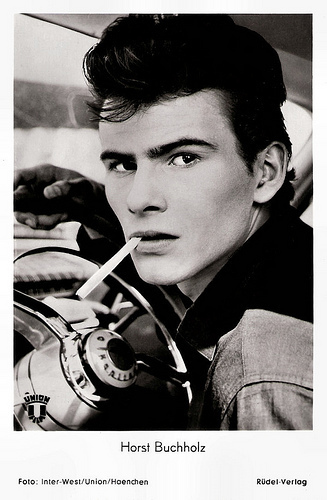
Horst Buchholz . German postcard by Franz-Josef Rüdel, Hamburg-Bergedorf, no. 1858. Photo: Interwest / Union-Film / Haenchen. Publicity still for Die Halbstarken/Teenage Wolfpack (Georg Tressler, 1956).
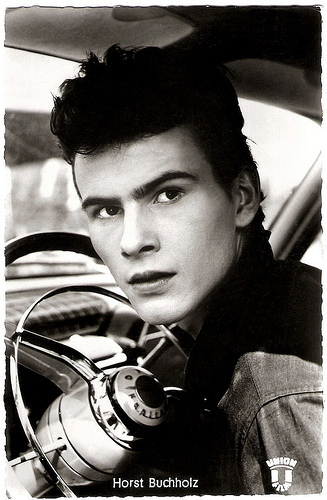
Horst Buchholz . German postcard by Kolibri-Verlag, Minden Westf., no. 2204. Photo: Interwest / Union-Film. Publicity still for Die Halbstarken/Teenage Wolfpack (Georg Tressler, 1956).
A soda-sucking Lolita
At his blog Pause Rewind Obsess , Tim Lucas writes: "in his fourth credited screen appearance, Buchholz actually pulls off something comparable to what John Travolta achieved in Saturday Night Fever. He is positively magnetic in his dramatic scenes, which lets us believe the power he exudes over his mates, but he explodes onscreen - as they say - when he jitterbugs with his girlfriend (future krimi queen Karin Baal ) at a local bar."
Karin Baal was chosen out 300 girls, who had joined a talent search for the part. Tim Lucas: "Playing a 15 year old girl, she looks and acts sophisticated beyond her years, but was in fact only 15 (sic, she was 16) in real life; never was she more photogenic or captivating than she is here. A soda-sucking Lolita who matures on our watch into a manipulative, trigger-pulling femme fatale, Baal's Sissy Bohl is an unforgettable character."
For the German release some of the voices of the young and inexperienced performers had been dubbed. Brigitte Grothum for instance dubbed for Karin Baal and Lutz Moik for Kalle Gaffkus.
In 1957 Die Halbstarken could be seen in a dubbed version, titled Teenage Wolfpack - in Britain and the US as well. The tagline was "Think of a law, they've broken it. Think of a crime, they've committed it." The American distributor billed Horst Buchholz as 'Henry Bookholt', and Karin Baal as 'Karen' Baal to help disguise the foreign origin of the film.
Director Georg Tressler was awarded the Filmband in Silber (Silver Filmband) as best new director in 1957. After Die Halbstarken, he made many films and TV productions until the 1990s. Will Tremper continued as a screenwriter and director of nonconformist films. He passed away in 1998.
While Horst Buchholz became an international Star and died in 2003, Karin Baal and Christian Doermer have made their own careers in German Film and Television.
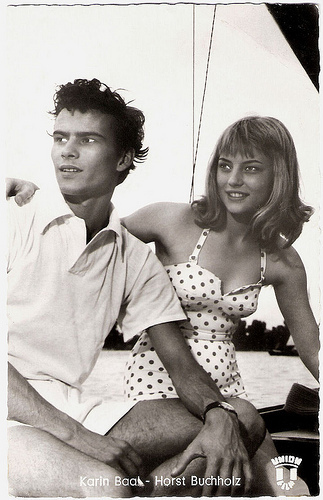
Karin Baal and Horst Buchholz . German postcard by Kolibri-Verlag, Minden/Westf., no. 2202. Photo: Interwest / Union / Haenchen. Publicity still for Die Halbstarken (1956).
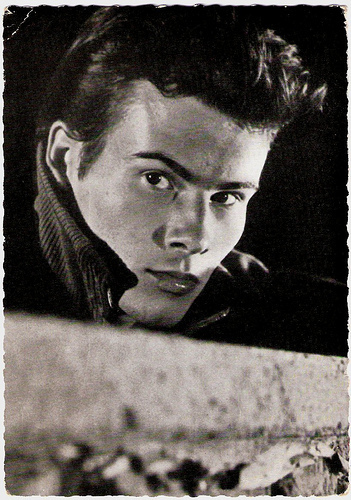
Horst Buchholz. German postcard by Filmbilder-Vertrieb Ernst Freihoff, Essen, no. 140. Photo: Union Film / Kiehl. Publicity still for Die Halbstarken/Teenage Wolfpck (1956).
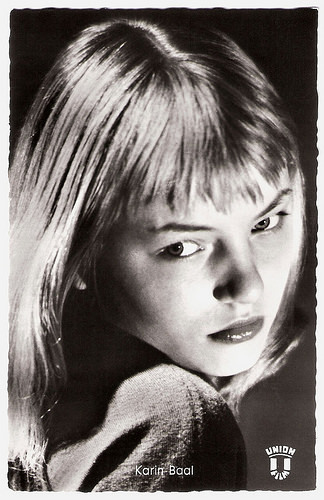
Karin Baal . German postcard by Kolibri-Verlag, Minden/Westf., no. 2096. Photo: Interwest / Union. Publicity still for Die Halbstarken (1956).
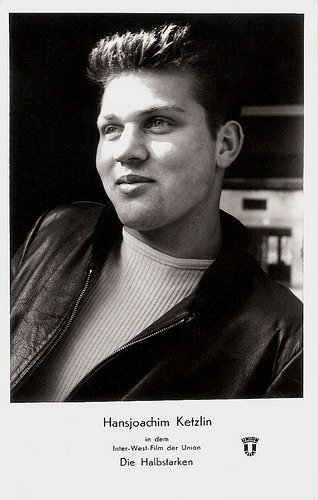
Hansjoachim Ketzlin. German postcard by Labaphot. Photo: Interwest / Union / Haenchen. Publicity still for Die Halbstarken (Georg Tressler, 1956). Ketzlin played Willi. During the 1970s, he returned to the cinema as an actor in soft sex films. He also produced three films, including the mediocre thriller Das Amulett des Todes/Cold Blood (Ralf Gregan, Günter Vaessen, 1975) starring Rutger Hauer before his Hollywood breakthrough.
Sources: Volker Scheunert (IMDb), Tim Lucas (Pause Rewind Obsess), Wikipedia (German), Filmportal.de, and IMDb.

German postcard by Kolibri-Verlag, Minden/Westf., no. 2329. Photo: Interwest / Union / Haenchen. Publicity still for Die Halbstarken (1956).

Austrian postcard by Lichtbild-Vertrieb Paula Weizmann, Wien, no. F 7. Photo: Interwest / Union-Film / Haenchen. Publicity still for Die Halbstarken/Teenage Wolfpack (Georg Tressler, 1956).
Hard, raw and realistic
Young author Will Tremper did not like the sentimental films that were made in Germany and Austria during the 1950s. While German film makers produced cheesy Heimatfilms and family comedies, Hollywood presented energetic teen dramas as The Wild One (Laslo Benedek, 1953) with Marlon Brando, The Blackboard Jungle (Richard Brooks, 1955) and Rebel Without a Cause (Nicholas Ray, 1955), featuring James Dean.
In that vein, Tremper and director Georg Tressler decided to make a film that would become a classic of German post-war cinema.
With the exception of lead actor Horst Buchholz , they chose non-professionals to play the young gang members. Remarkable is also that the jukebox doesn't play the then new and hot rock & roll, but jazz music. Composer Martin Böttcher made the Soundtrack with Mister Martins Band.
The result was a sensation. According to Hal Erickson at AllMovie , the young actors are "exuding a raw energy that many 'pros' could not emulate.
For Volker Scheunert at IMDb , Die Halbstarken/Teenage Wolfpack (Georg Tressler, 1956) is his favourite German film of the 1950s: "This one is hard, raw and realistic, omitting any false sentimentality or romanticism."

Horst Buchholz . German postcard by Kolibri-Verlag, Minden Westf., no. 2171. Photo: Interwest / Union-Film / Haenchen. Publicity still for Die Halbstarken/Teenage Wolfpack (Georg Tressler, 1956).

Karin Baal . German postcard by Kolibri-Verlag, Minden/Westf. Photo: Interwest / Union / Haenchen. Publicity still for Die Halbstarken (1956).

Christian Doermer . German postcard by Kolibri-Verlag, Minden-Westf., no. 140.
Dreaming of a Buick Cabriolet
Die Halbstarken - what can be translated as The Hooligans - was shot on location in West Berlin in 1955 and 1956.
Horst Buchholz plays 19-year old Freddy Borchert, who has been thrown out of his home by his overly strict father (Paul Wagner) and the charismatic but tough teenager has to survive on the streets of West-Berlin.
In an indoor swimming pool he meets his younger brother Jan ( Christian Doermer ). Freddy pretends to have a good job but he has risen to the head of a youth gang and leads a life of crime.
Jan knows that his parents need the huge sum of 3,000 Deutschmarks to pay their debts, and asks his brother if he could help them. Freddy says yes for his mother’s sake. He is preparing his 'biggest coup' ever: a mail car robbery that would not only allow him to help his parents but to fulfil his dream - buying a Buick Cabriolet.
But the robbery goes wrong. In order to reassert himself as the leader of the pack and to prove to his girlfriend Sissy ( Karin Baal ) that he is a man, Freddy breaks into the a villa of a wealthy man. Surprised by the owner, the situation escalates.

Horst Buchholz . German postcard by Franz-Josef Rüdel, Hamburg-Bergedorf, no. 1858. Photo: Interwest / Union-Film / Haenchen. Publicity still for Die Halbstarken/Teenage Wolfpack (Georg Tressler, 1956).

Horst Buchholz . German postcard by Kolibri-Verlag, Minden Westf., no. 2204. Photo: Interwest / Union-Film. Publicity still for Die Halbstarken/Teenage Wolfpack (Georg Tressler, 1956).
A soda-sucking Lolita
At his blog Pause Rewind Obsess , Tim Lucas writes: "in his fourth credited screen appearance, Buchholz actually pulls off something comparable to what John Travolta achieved in Saturday Night Fever. He is positively magnetic in his dramatic scenes, which lets us believe the power he exudes over his mates, but he explodes onscreen - as they say - when he jitterbugs with his girlfriend (future krimi queen Karin Baal ) at a local bar."
Karin Baal was chosen out 300 girls, who had joined a talent search for the part. Tim Lucas: "Playing a 15 year old girl, she looks and acts sophisticated beyond her years, but was in fact only 15 (sic, she was 16) in real life; never was she more photogenic or captivating than she is here. A soda-sucking Lolita who matures on our watch into a manipulative, trigger-pulling femme fatale, Baal's Sissy Bohl is an unforgettable character."
For the German release some of the voices of the young and inexperienced performers had been dubbed. Brigitte Grothum for instance dubbed for Karin Baal and Lutz Moik for Kalle Gaffkus.
In 1957 Die Halbstarken could be seen in a dubbed version, titled Teenage Wolfpack - in Britain and the US as well. The tagline was "Think of a law, they've broken it. Think of a crime, they've committed it." The American distributor billed Horst Buchholz as 'Henry Bookholt', and Karin Baal as 'Karen' Baal to help disguise the foreign origin of the film.
Director Georg Tressler was awarded the Filmband in Silber (Silver Filmband) as best new director in 1957. After Die Halbstarken, he made many films and TV productions until the 1990s. Will Tremper continued as a screenwriter and director of nonconformist films. He passed away in 1998.
While Horst Buchholz became an international Star and died in 2003, Karin Baal and Christian Doermer have made their own careers in German Film and Television.

Karin Baal and Horst Buchholz . German postcard by Kolibri-Verlag, Minden/Westf., no. 2202. Photo: Interwest / Union / Haenchen. Publicity still for Die Halbstarken (1956).

Horst Buchholz. German postcard by Filmbilder-Vertrieb Ernst Freihoff, Essen, no. 140. Photo: Union Film / Kiehl. Publicity still for Die Halbstarken/Teenage Wolfpck (1956).

Karin Baal . German postcard by Kolibri-Verlag, Minden/Westf., no. 2096. Photo: Interwest / Union. Publicity still for Die Halbstarken (1956).

Hansjoachim Ketzlin. German postcard by Labaphot. Photo: Interwest / Union / Haenchen. Publicity still for Die Halbstarken (Georg Tressler, 1956). Ketzlin played Willi. During the 1970s, he returned to the cinema as an actor in soft sex films. He also produced three films, including the mediocre thriller Das Amulett des Todes/Cold Blood (Ralf Gregan, Günter Vaessen, 1975) starring Rutger Hauer before his Hollywood breakthrough.
Sources: Volker Scheunert (IMDb), Tim Lucas (Pause Rewind Obsess), Wikipedia (German), Filmportal.de, and IMDb.
Published on January 23, 2015 22:00
January 22, 2015
Marcella Albani
Petite Italian actress and author Marcella Albani (1899-1959) appeared in 50 films from 1919 on. She was especially successful as elegant Latin lady in the German silent cinema.
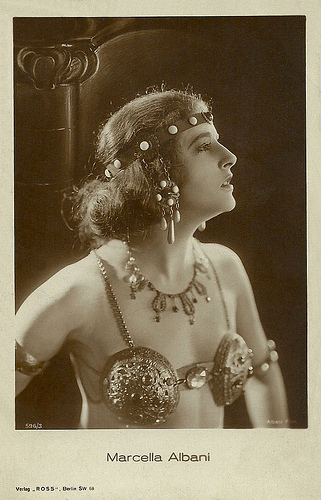
German postcard by Ross Verlag, Berlin, no. 596/3, 1925-1926. Photo: Albani Film. Collection: Didier Hanson.
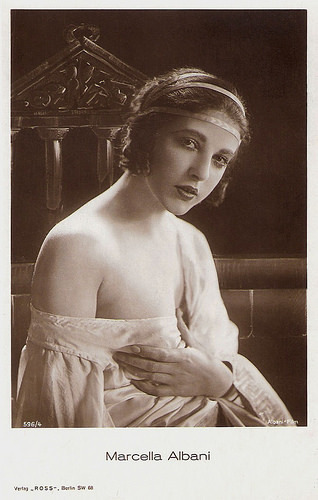
German postcard by Ross Verlag, Berlin, no. 596/4, 1919-1924. Photo: Albani-Film.
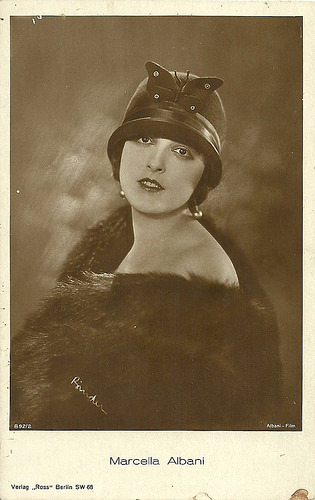
German postcard by Ross Verlag, no. 892/2, 1925-1926. Photo: Alex Binder / Albani Film.
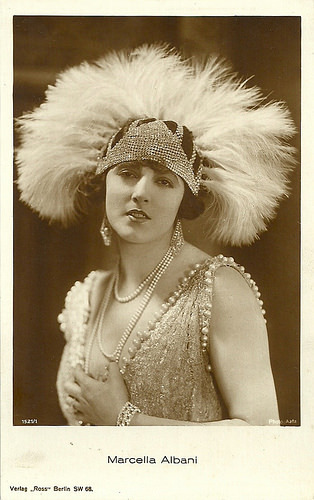
German postcard by Ross Verlag, Berlin, no. 1521/1, 1927-1928. Photo: Aafa Film.
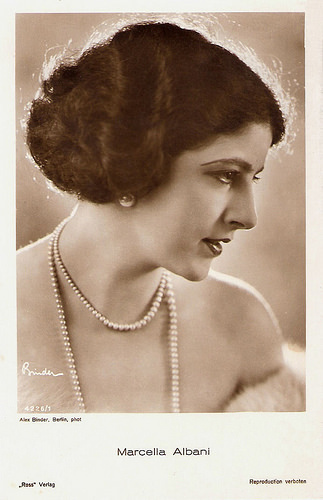
German postcard by Ross-Verlag, Berlin, no. 4226/1, 1929-1930. Photo: Alex Binder.
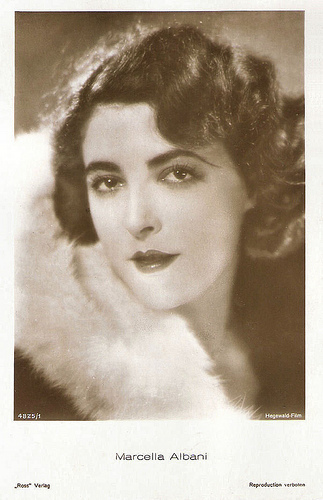
German postcard by Ross Verlag, no. 4825/1, 1929-1930. Photo: Hegewald Film.
Ambrosio
Marcella Albani was born as Ida Maranca in the village of Albano Laziale near Rome, in 1899. Her father was the owner of a popular hosteria in Trastevere.
Shortly after finishing her grammar school, she met the Roman aristocrat Guido Parish. The actor-director gave her the stage name Marcella Albani and directed her in her first film, L'amplesso della morte/The Embrace of the Dead (1919).
For Ambrosio Film in Turin they made a series of melodramas and adventure films, including Salvator (1920), La figlia delle onde/The Daughter of the Waves (1921), Amore in fuga/Love on the Run (1921) and Bufera/Buffalo (1922).
Sadly in 1922 the legendary Ambrosio film company went bankrupt, and Parish had to sell out their films.
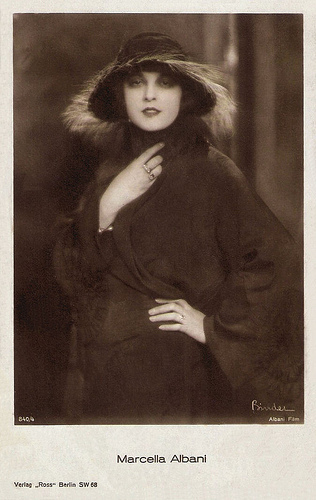
German postcard by Ross Verlag, no. 240/4, 1919-1924. Photo: Alex Binder / Albani Film.
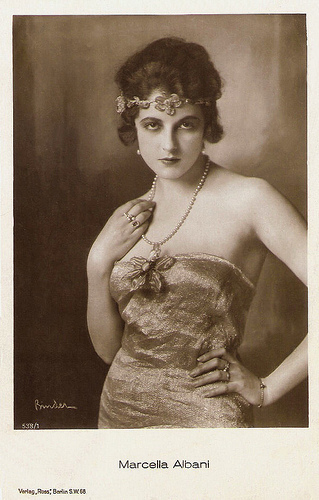
German postcard by Ross Verlag, Berlin, no. 538/1, 1919-1924. Photo: Alex Binder.
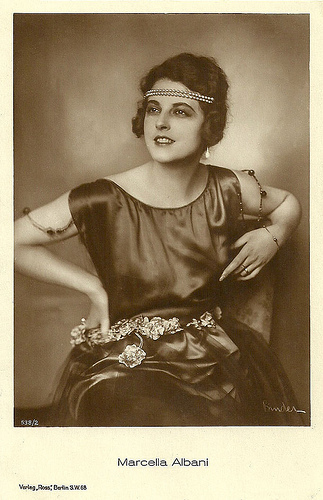
German postcard by Ross Verlag, Berlin, no. 538/2, 1919-1924. Photo: Alex Binder.
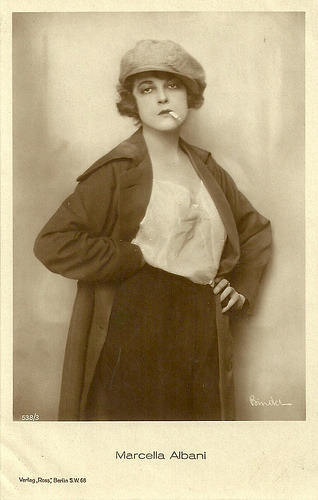
German postcard by Ross Verlag, Berlin, no. 538/3, 1919-1924. Photo: Alex Binder. Marcella Albani in the film Das Spiel der Liebe/The Game of Love (Guido Parish, 1924).
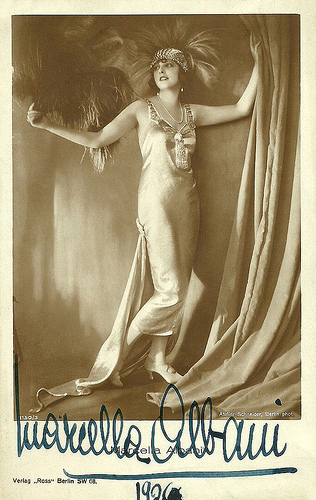
German postcard by Ross Verlag, no. 1750/3, 1926. Photo: Atelier Schneider, Berlin. Collection: Didier Hanson.
Absolute Peak in Popularity
In 1923 Marcella Albani and Guido Parish went to Berlin. In 1923 she appeared in Frauenschicksal/Woman's Destiny (1923) and Im Rausche der Leidenschaft (1923) with Alfred Abel.
Marcella was an instant success in Germany. Other films were Das Spiel der Liebe/The Game of Love (1924) with Alfred Abel , Guillotine (1924) with Willy Fritsch , and Die Flucht in den Zirkus/The Circus of Life (1926) with Vladimir Gajdarov , which she made with her own company Marcella Albani Film GmbH, and which were directed by Guido Parish under the pseudonym Guido Schamberg.
During this period she portrayed mainly elegant Latin beauties. In 1926, her cooperation with Parish ended and she went on to make films with famous directors like Joe May and Friedrich Zelnik .
Albani experienced her absolute peak in popularity between 1927 and 1929 when she made twenty films within three years. These included Das Geheimnis des Abbe X/Behind the Altar (Julius Brandt, Wilhelm Dieterle, 1927) and Fürst oder Clown/Prince or Clown (Aleksandr Razumnyj, 1928) with Iván Petrovich .
Her engagements led her to France for L’évadée/The Escapist (Henri Ménessier, 1928), Austria for Das Weib am Kreuze/The Female at the Cross (Guido Brignone, 1929), Czechoslovakia for Hricy Lasky/The Last Mask (Carl Lamac, 1930) and to Italy for Corte d'Assise/Before the Jury (Guido Brignone, 1931).
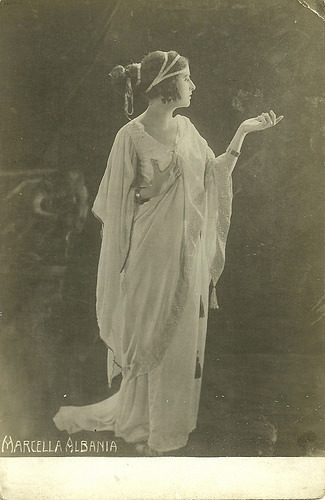
Probably French postcard, editor unknown. Strangely enough, the named is spelled Albania here. Written on the back: Marcella Albani, 1926.
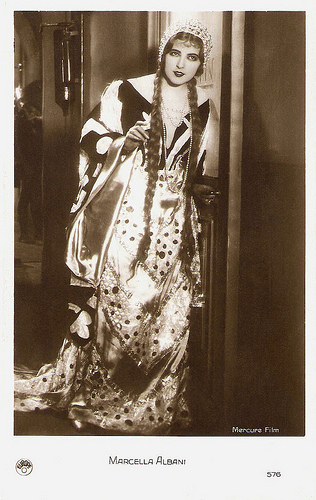
French postcard by Europe, no. 576. Photo: Mercure Film.
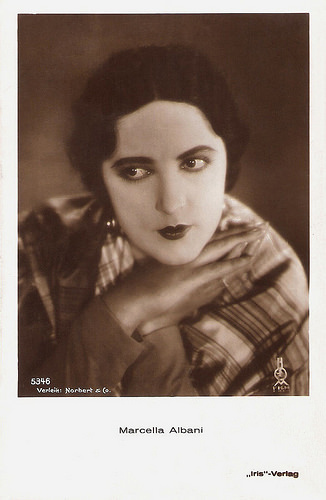
Austrian postcard by Iris-Verlag, Berlin, no. 5346. Photo: Norbert & Co. / HOM.
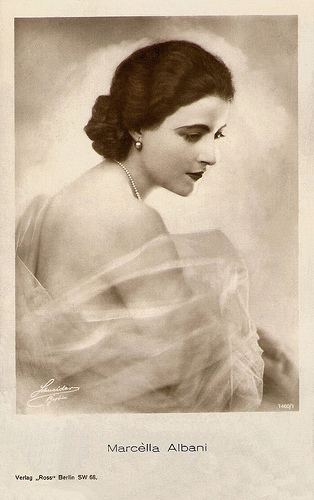
German postcard by Ross Verlag, no. 1450/1, 1927-1928. Photo: Ernst Schneider, Berlin.
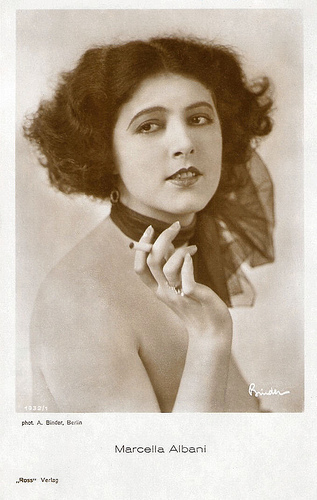
German postcard by Ross Verlag, no. 1931/1, 1927-1928. Photo: Alex Binder, Berlin.
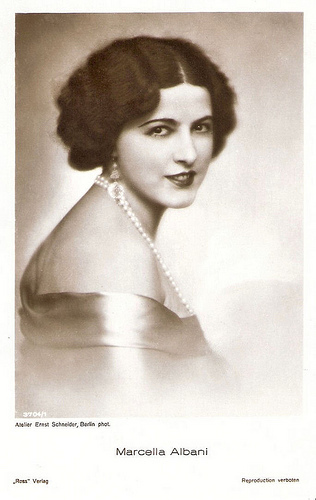
German postcard by Ross Verlag, no. 3704/1, 1928-1929. Photo: Ernst Schneider, Berlin.
Coppa Volpi
After the advance of sound film, Marcella Albani turned to writing. She published novels like Glauca, l'amata l'innamorata (Glauce, the Beloved Lover) and La Citta dell' Amore (The City of Love). The latter was adapted for the screen with her by director Mario Franchini, La Citta dell' Amore/The City of Love (1934).
Since 1931 Franchini was also her husband, with whom she had a child. Incidentally she made films like Stradivarius (Albert Valentin, Géza von Bolváry, 1935) with Pierre Richard-Willm and Edwige Feuillère , and the German language version, Stradivari (Géza von Bolváry, 1935) with Gustav Fröhlich and Sybille Schmitz .
Her last film was the German Western Der Kaiser von Kalifornien/The Emperor of California (Luis Trenker, 1936) starring director Trenker himself, with whom she had worked before at Der Kampf am Matterhorn/Fight for the Matterhorn (Mario Bonnard, Nunzio Malasomma, 1926). Der Kaiser von Kalifornien was awarded the Coppa Volpi at the Venice Film Festival in 1937.
After this she retired from the film business and lived at the Ligurian coast. She made one last film, after the war, the Austrian production Ein bezaubernder Schwindler/A Charming Crook (Hans Wolff, 1949).
Marcella Albani died of a tumour in 1959, in Bad Goedesberg, Germany.
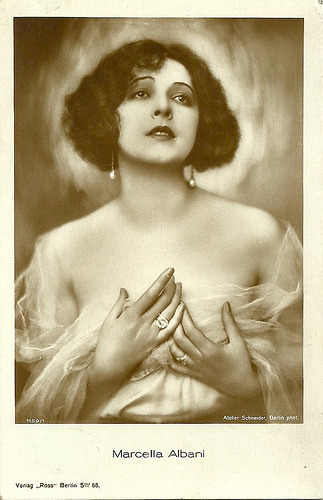
German postcard by Ross Verlag, no. 1150/1, 1927-1928. Photo: Atelier Schneider, Berlin.
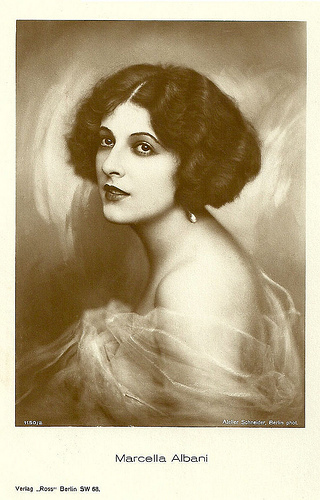
German postcard by Ross Verlag, no. 1150/2, 1919-1924. Photo Atelier Schneider, Berlin.
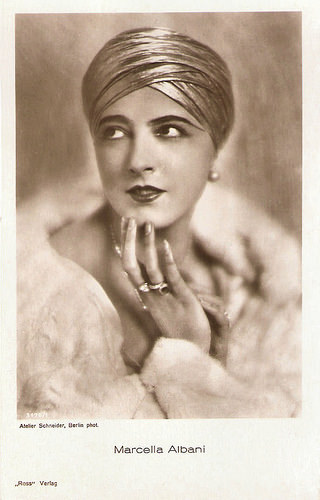
German postcard by Ross Verlag, no. 3170/1, 1928-1929. Photo: Atelier Schneider.
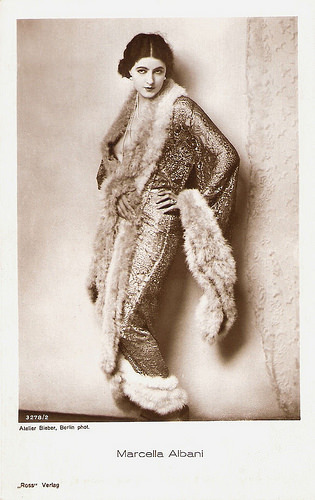
German postcard by Ross Verlag, no. 3278/2, 1928-1929. Photo: Atelier Bieber, Berlin.
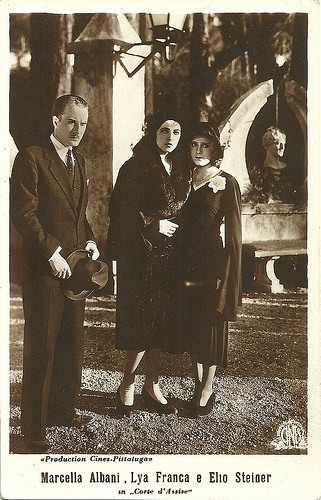
Italian postcard. Photo: Cines-Pittaluga. Marcella Albani, Lya Franca and Elio Steiner in Corte d'Assise/Before the Jury (Guido Brignone, 1930), the second Italian sound film, after La canzone dell'amore, and one the first Italian court case crime stories.
Sources: Vittorio Martinelli (Le Dive del Silenzio - Italian), Stefano Cocciardi (MarcellaAlbani.eu - Italian), Thomas Staedeli (Cyranos), Filmportal.de, Wikipedia and .

German postcard by Ross Verlag, Berlin, no. 596/3, 1925-1926. Photo: Albani Film. Collection: Didier Hanson.

German postcard by Ross Verlag, Berlin, no. 596/4, 1919-1924. Photo: Albani-Film.

German postcard by Ross Verlag, no. 892/2, 1925-1926. Photo: Alex Binder / Albani Film.

German postcard by Ross Verlag, Berlin, no. 1521/1, 1927-1928. Photo: Aafa Film.

German postcard by Ross-Verlag, Berlin, no. 4226/1, 1929-1930. Photo: Alex Binder.

German postcard by Ross Verlag, no. 4825/1, 1929-1930. Photo: Hegewald Film.
Ambrosio
Marcella Albani was born as Ida Maranca in the village of Albano Laziale near Rome, in 1899. Her father was the owner of a popular hosteria in Trastevere.
Shortly after finishing her grammar school, she met the Roman aristocrat Guido Parish. The actor-director gave her the stage name Marcella Albani and directed her in her first film, L'amplesso della morte/The Embrace of the Dead (1919).
For Ambrosio Film in Turin they made a series of melodramas and adventure films, including Salvator (1920), La figlia delle onde/The Daughter of the Waves (1921), Amore in fuga/Love on the Run (1921) and Bufera/Buffalo (1922).
Sadly in 1922 the legendary Ambrosio film company went bankrupt, and Parish had to sell out their films.

German postcard by Ross Verlag, no. 240/4, 1919-1924. Photo: Alex Binder / Albani Film.

German postcard by Ross Verlag, Berlin, no. 538/1, 1919-1924. Photo: Alex Binder.

German postcard by Ross Verlag, Berlin, no. 538/2, 1919-1924. Photo: Alex Binder.

German postcard by Ross Verlag, Berlin, no. 538/3, 1919-1924. Photo: Alex Binder. Marcella Albani in the film Das Spiel der Liebe/The Game of Love (Guido Parish, 1924).

German postcard by Ross Verlag, no. 1750/3, 1926. Photo: Atelier Schneider, Berlin. Collection: Didier Hanson.
Absolute Peak in Popularity
In 1923 Marcella Albani and Guido Parish went to Berlin. In 1923 she appeared in Frauenschicksal/Woman's Destiny (1923) and Im Rausche der Leidenschaft (1923) with Alfred Abel.
Marcella was an instant success in Germany. Other films were Das Spiel der Liebe/The Game of Love (1924) with Alfred Abel , Guillotine (1924) with Willy Fritsch , and Die Flucht in den Zirkus/The Circus of Life (1926) with Vladimir Gajdarov , which she made with her own company Marcella Albani Film GmbH, and which were directed by Guido Parish under the pseudonym Guido Schamberg.
During this period she portrayed mainly elegant Latin beauties. In 1926, her cooperation with Parish ended and she went on to make films with famous directors like Joe May and Friedrich Zelnik .
Albani experienced her absolute peak in popularity between 1927 and 1929 when she made twenty films within three years. These included Das Geheimnis des Abbe X/Behind the Altar (Julius Brandt, Wilhelm Dieterle, 1927) and Fürst oder Clown/Prince or Clown (Aleksandr Razumnyj, 1928) with Iván Petrovich .
Her engagements led her to France for L’évadée/The Escapist (Henri Ménessier, 1928), Austria for Das Weib am Kreuze/The Female at the Cross (Guido Brignone, 1929), Czechoslovakia for Hricy Lasky/The Last Mask (Carl Lamac, 1930) and to Italy for Corte d'Assise/Before the Jury (Guido Brignone, 1931).

Probably French postcard, editor unknown. Strangely enough, the named is spelled Albania here. Written on the back: Marcella Albani, 1926.

French postcard by Europe, no. 576. Photo: Mercure Film.

Austrian postcard by Iris-Verlag, Berlin, no. 5346. Photo: Norbert & Co. / HOM.

German postcard by Ross Verlag, no. 1450/1, 1927-1928. Photo: Ernst Schneider, Berlin.

German postcard by Ross Verlag, no. 1931/1, 1927-1928. Photo: Alex Binder, Berlin.

German postcard by Ross Verlag, no. 3704/1, 1928-1929. Photo: Ernst Schneider, Berlin.
Coppa Volpi
After the advance of sound film, Marcella Albani turned to writing. She published novels like Glauca, l'amata l'innamorata (Glauce, the Beloved Lover) and La Citta dell' Amore (The City of Love). The latter was adapted for the screen with her by director Mario Franchini, La Citta dell' Amore/The City of Love (1934).
Since 1931 Franchini was also her husband, with whom she had a child. Incidentally she made films like Stradivarius (Albert Valentin, Géza von Bolváry, 1935) with Pierre Richard-Willm and Edwige Feuillère , and the German language version, Stradivari (Géza von Bolváry, 1935) with Gustav Fröhlich and Sybille Schmitz .
Her last film was the German Western Der Kaiser von Kalifornien/The Emperor of California (Luis Trenker, 1936) starring director Trenker himself, with whom she had worked before at Der Kampf am Matterhorn/Fight for the Matterhorn (Mario Bonnard, Nunzio Malasomma, 1926). Der Kaiser von Kalifornien was awarded the Coppa Volpi at the Venice Film Festival in 1937.
After this she retired from the film business and lived at the Ligurian coast. She made one last film, after the war, the Austrian production Ein bezaubernder Schwindler/A Charming Crook (Hans Wolff, 1949).
Marcella Albani died of a tumour in 1959, in Bad Goedesberg, Germany.

German postcard by Ross Verlag, no. 1150/1, 1927-1928. Photo: Atelier Schneider, Berlin.

German postcard by Ross Verlag, no. 1150/2, 1919-1924. Photo Atelier Schneider, Berlin.

German postcard by Ross Verlag, no. 3170/1, 1928-1929. Photo: Atelier Schneider.

German postcard by Ross Verlag, no. 3278/2, 1928-1929. Photo: Atelier Bieber, Berlin.

Italian postcard. Photo: Cines-Pittaluga. Marcella Albani, Lya Franca and Elio Steiner in Corte d'Assise/Before the Jury (Guido Brignone, 1930), the second Italian sound film, after La canzone dell'amore, and one the first Italian court case crime stories.
Sources: Vittorio Martinelli (Le Dive del Silenzio - Italian), Stefano Cocciardi (MarcellaAlbani.eu - Italian), Thomas Staedeli (Cyranos), Filmportal.de, Wikipedia and .
Published on January 22, 2015 22:00
January 21, 2015
Ossip Runitsch
Russian actor, producer and stage director Ossip Runitsch (1889-1947) was one of the biggest stars of the Russian silent film and one of the first iconic figures of the early Russian cinema. After the October revolution, he worked in Latvia, Italy, Germany, France and South-Africa.
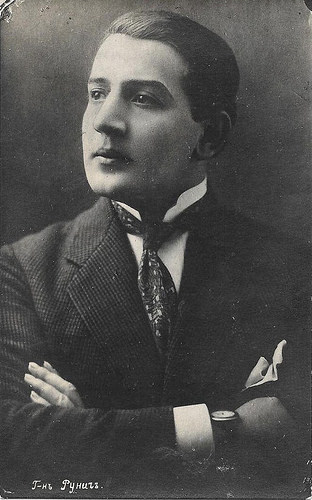
Russian postcard. Collection: Didier Hanson.
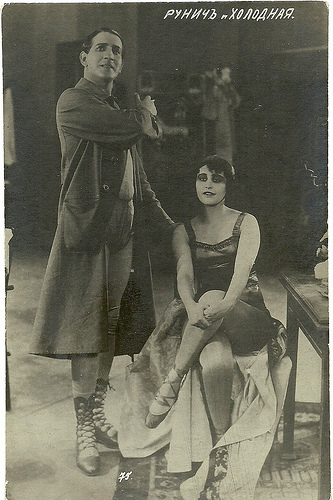
Russian postcard, no. 75. Collection: Didier Hanson. Publicity still for Posledneiye tango/Last Tango (Vyacheslav Viskovsky, 1918) with Vera Kholodnaya .
Last tango
Ossip (or Osip) Runitsch was born as Osip Fradkin in Saint-Petersburg, the Russian Empire in 1889, according to Wikipedia . IMDb gives as his birth name Osip Ivanovich Runich.
He started his acting career on stage and worked for the Moscow Art Theatre and the Hermitage Theatre in Saint-Petersburg.
In 1915-1919 he starred in some successful silent films of that time, such as the historical drama Voyna i mir/War and Peace (Vladimir Gardin, Yakov Protazanov, 1915) with Vera Karalli , and Pesn torzhestvuyushchey lyubvi/Song of Triumphant Love(Yevgeni Bauer, 1915) with Vera Kholodnaya .
He co-starred again with Kholodnaya in the circus drama Molchi, grust... molchi/Be silent, sorrow ... be silent (Pyotr Chardynin, 1918), and Posledneiye tango/Last tango (Vyacheslav Viskovsky, 1918).
According to Wikipedia , Runitsch was a long-time admirer of the beautiful Vera Kholodnaya and was devastated after her early death in 1919.
During the Russian Civil War, Ossip Runitsch thus fled Russia. He lived for a while in Riga, Latvia, where he played in the troupe of Russian Drama Theatre.
Then he left for Italy. Credited as Giuseppe Runitsch, he took part in a number of Italian films, including L'orchidea fatale/The fatal orchid (Alessandro Rosenfeld, Aleksandr Uralsky, 1920) and L'automobile errante/The wandering car (Arturo Ambrosio Jr., Achille Consalvi, 1921).
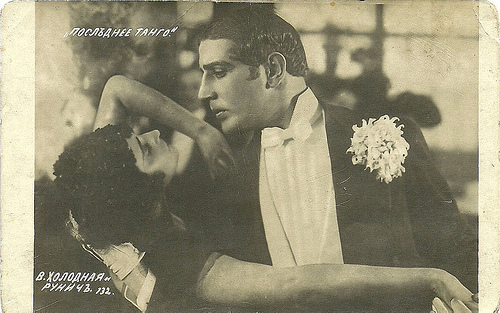
Russian postcard, no. 132. Collection: Didier Hanson. Publicity still for Posledneiye tango/Last Tango (Vyacheslav Viskovsky, 1918) with Vera Kholodnaya . Only about 10 minutes of this film are known to exist. The rest of the film is believed lost.
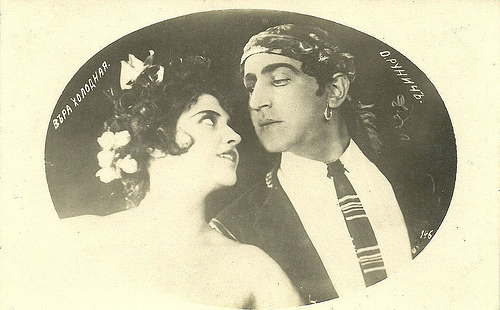
Russian postcard, no. 146. Collection: Didier Hanson. Publicity still for Posledneiye tango/Last Tango (Vyacheslav Viskovsky, 1918) with Vera Kholodnaya .
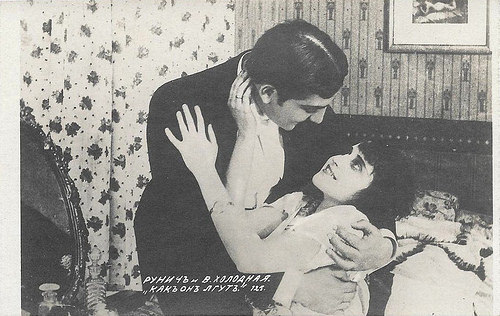
Ossip Runitsch and Vera Kholodnaya . Russian postcard, no. 125. Collection: Didier Hanson.
Playing with Fire
In 1921, Ossip Runitsch moved on to Berlin, then the burgeoning film capital of Europe.
In Germany he co-starred as Camille Desmoulins in the silent historical film Danton (Dimitri Buchowetzki, 1921) opposite Emil Jannings as Danton and Werner Krauss as Robespierre. The film was based on the play Danton's Death by Georg Büchner.
Interesting was also the silent comedy-drama Das Spiel mit dem Feuer/Playing with Fire (Georg Kroll, Robert Wiene, 1921). Diana Karenne starred as a method actress, who likes living out the roles she is playing in real life. To prepare for her new play, she enters the criminal underworld and ends up being implicated in a burglary of a Duke who is one of her suitors.
Runitsch also worked with director Robert Wiene on Der Puppenmacher von Kiang-Ning/The Doll Maker of Kiang-Ning (Robert Wiene, 1923) with Werner Krauss as a doll maker in China who crafts a puppet which he is convinced is lifelike.
In 1925 Runitsch married Nina Pavlishcheva, a ballet dancer. They often worked in Paris, where Runitsch worked on Russian emigrant stage productions, plays but ballets and operas as well. He also taught at a Russian theatre academy in Paris.
One of his last silent films was the German drama Tagebuch einer Kokotte/Diary of a Coquette (Constantin J. David, 1929) starring Fee Malten . A year later, sound and his accent finished his film career.
In 1933, he and his wife accepted an invitation to tour South Africa from local Jewish friends. They stayed in South Africa and Runitsch became a founder of one of the first professional theatre companies in a country, the Johannesburg Studio. Besides, he produced operas for the State Theatre in mid-1940s.
Ossip Runitsch died in 1947 in Johannesburg, South Africa.
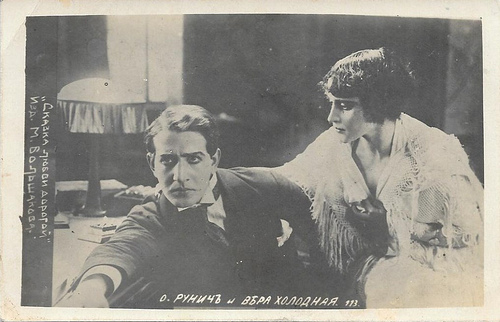
Ossip Runitsch and Vera Kholodnaya . Russian postcard, no. 30. Collection: Didier Hanson.
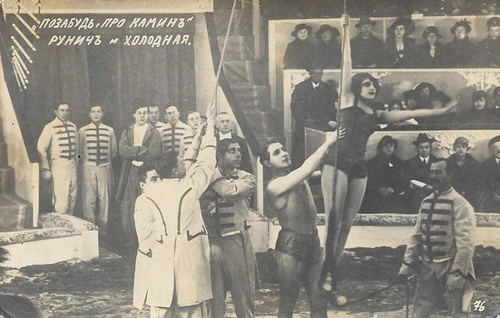
Russian postcard, no. 30. Publicity still for Molchi, grust... molchi/Be silent, sorrow ... be silent (Pyotr Chardynin, 1918) with Vera Kholodnaya . Collection: Didier Hanson.
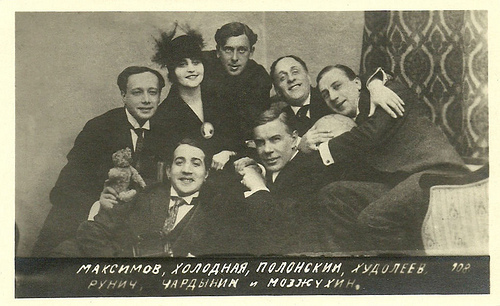
A Who is Who of the Russian silent cinema. In a circle from left: actor Vladimir Maksimov (with bear), actress Vera Kholodnaya , actor Vitold Polonsky, actor Ivan Khudoleyev, actor Ivan Mozzhukin , actor-director Pyotr Chardynin and Ossip Runitsch. Russian postcard, no. 108. Collection: Didier Hanson.
Sources: Wikipedia (German and English) and .

Russian postcard. Collection: Didier Hanson.

Russian postcard, no. 75. Collection: Didier Hanson. Publicity still for Posledneiye tango/Last Tango (Vyacheslav Viskovsky, 1918) with Vera Kholodnaya .
Last tango
Ossip (or Osip) Runitsch was born as Osip Fradkin in Saint-Petersburg, the Russian Empire in 1889, according to Wikipedia . IMDb gives as his birth name Osip Ivanovich Runich.
He started his acting career on stage and worked for the Moscow Art Theatre and the Hermitage Theatre in Saint-Petersburg.
In 1915-1919 he starred in some successful silent films of that time, such as the historical drama Voyna i mir/War and Peace (Vladimir Gardin, Yakov Protazanov, 1915) with Vera Karalli , and Pesn torzhestvuyushchey lyubvi/Song of Triumphant Love(Yevgeni Bauer, 1915) with Vera Kholodnaya .
He co-starred again with Kholodnaya in the circus drama Molchi, grust... molchi/Be silent, sorrow ... be silent (Pyotr Chardynin, 1918), and Posledneiye tango/Last tango (Vyacheslav Viskovsky, 1918).
According to Wikipedia , Runitsch was a long-time admirer of the beautiful Vera Kholodnaya and was devastated after her early death in 1919.
During the Russian Civil War, Ossip Runitsch thus fled Russia. He lived for a while in Riga, Latvia, where he played in the troupe of Russian Drama Theatre.
Then he left for Italy. Credited as Giuseppe Runitsch, he took part in a number of Italian films, including L'orchidea fatale/The fatal orchid (Alessandro Rosenfeld, Aleksandr Uralsky, 1920) and L'automobile errante/The wandering car (Arturo Ambrosio Jr., Achille Consalvi, 1921).

Russian postcard, no. 132. Collection: Didier Hanson. Publicity still for Posledneiye tango/Last Tango (Vyacheslav Viskovsky, 1918) with Vera Kholodnaya . Only about 10 minutes of this film are known to exist. The rest of the film is believed lost.

Russian postcard, no. 146. Collection: Didier Hanson. Publicity still for Posledneiye tango/Last Tango (Vyacheslav Viskovsky, 1918) with Vera Kholodnaya .

Ossip Runitsch and Vera Kholodnaya . Russian postcard, no. 125. Collection: Didier Hanson.
Playing with Fire
In 1921, Ossip Runitsch moved on to Berlin, then the burgeoning film capital of Europe.
In Germany he co-starred as Camille Desmoulins in the silent historical film Danton (Dimitri Buchowetzki, 1921) opposite Emil Jannings as Danton and Werner Krauss as Robespierre. The film was based on the play Danton's Death by Georg Büchner.
Interesting was also the silent comedy-drama Das Spiel mit dem Feuer/Playing with Fire (Georg Kroll, Robert Wiene, 1921). Diana Karenne starred as a method actress, who likes living out the roles she is playing in real life. To prepare for her new play, she enters the criminal underworld and ends up being implicated in a burglary of a Duke who is one of her suitors.
Runitsch also worked with director Robert Wiene on Der Puppenmacher von Kiang-Ning/The Doll Maker of Kiang-Ning (Robert Wiene, 1923) with Werner Krauss as a doll maker in China who crafts a puppet which he is convinced is lifelike.
In 1925 Runitsch married Nina Pavlishcheva, a ballet dancer. They often worked in Paris, where Runitsch worked on Russian emigrant stage productions, plays but ballets and operas as well. He also taught at a Russian theatre academy in Paris.
One of his last silent films was the German drama Tagebuch einer Kokotte/Diary of a Coquette (Constantin J. David, 1929) starring Fee Malten . A year later, sound and his accent finished his film career.
In 1933, he and his wife accepted an invitation to tour South Africa from local Jewish friends. They stayed in South Africa and Runitsch became a founder of one of the first professional theatre companies in a country, the Johannesburg Studio. Besides, he produced operas for the State Theatre in mid-1940s.
Ossip Runitsch died in 1947 in Johannesburg, South Africa.

Ossip Runitsch and Vera Kholodnaya . Russian postcard, no. 30. Collection: Didier Hanson.

Russian postcard, no. 30. Publicity still for Molchi, grust... molchi/Be silent, sorrow ... be silent (Pyotr Chardynin, 1918) with Vera Kholodnaya . Collection: Didier Hanson.

A Who is Who of the Russian silent cinema. In a circle from left: actor Vladimir Maksimov (with bear), actress Vera Kholodnaya , actor Vitold Polonsky, actor Ivan Khudoleyev, actor Ivan Mozzhukin , actor-director Pyotr Chardynin and Ossip Runitsch. Russian postcard, no. 108. Collection: Didier Hanson.
Sources: Wikipedia (German and English) and .
Published on January 21, 2015 22:00
January 20, 2015
Aldo Graziati
Today in our series on film star photographers, Aldo Graziati (1905-1953) or simply Aldo. The Italian is known as the cinematographer of some of the classic films by Luchino Visconti. But before that, Aldo worked in France as a still photographer and he made iconic studio portraits of the most beautiful stars of the French cinema.
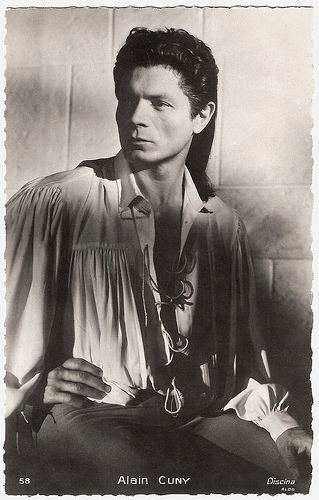
Alain Cuny . French postcard by E.C. Paris, no. 58. Photo: Aldò Graziati / Discina. Publicity still for Les visiteurs du soir (Marcel Carné, 1942).
Visconti
During his career as an actor, photographer, cameras operator and cinematographer Aldo Rossano Graziati was credited as Aldo Rossano, Aldo, G. Aldo and G.R. Aldo.
In 1947, he shot his first film, the short French documentary Couleur de Venise/Colour of Venice (Jean Faurez, Jacques Mercanton, 1947).
A year later, he worked with Luchino Visconti on the neorealist classic La Terra Trema/The Earth Trembles (Luchino Visconti, 1948), loosely adapted from Giovanni Verga's novel I Malavoglia (The House by the Medlar Tree).
The picture, a docufiction about the exploitation of working-class fishermen on Sicily, features non-professional actors, including the brothers Antonio Arcidiacono and Giuseppe Arcidiacono.
Aldo's sensitivity to location in this drama of poor Sicilian fishermen produced never-to-be-forgotten images in black-and-white. The physical beauty of the sea scenes and the contrasting landscapes never obscured the neorealistic approach of its director. La Terra Trema/The Earth Trembles received a Golden Lion at the 9th Venice International Film Festival in 1948.
Aldo was also the cinematographer of the Italian historical drama Cielo sulla palude/Heaven over the Marshes (Augusto Genina, 1949) portraying the life of the saint Maria Goretti, and the drama Domani è troppo tardi/Tomorrow Is Too Late (Léonide Moguy, 1950) with Pier Angeli . The film was awarded Best Italian Film at the Venice Film Festival.
Aldo worked three times for director Vittorio De Sica as the cinematographer of Miracolo a Milano/Miracle in Milan (Vittorio de Sica, 1951), the neorealist classic Umberto D. (Vittorio de Sica, 1952), and Stazione Termini/Indiscretion of an American Wife (Vittorio de Sica, 1953), starring Jennifer Jones and Montgomery Clift.
He also worked as one of the cinematographers of Orson Welles ' mythical Othello (1952). The film won the Best film award at the Cannes Film Festival in 1952.
Aldo's final film was the drama Senso (Luchino Visconti, 1954) with Alida Valli and Farley Granger. Senso was Visconti's and Aldo's first colour film and they obviously had put a lot of effort to it. Senso is visually gorgeous and meant an aesthetic revolution for Italian cinema.
During the production of the film, Aldo was killed in a car crash in Albara di Pianiga near Padua on 14 November 1953. British cinematographer Robert Krasker completed the film.
Aldo's cinematography for the film later received the Italian National Syndicate of Film Journalists' award. Visconti was nominated for the Golden Lion award at the 15th Venice International Film Festival.
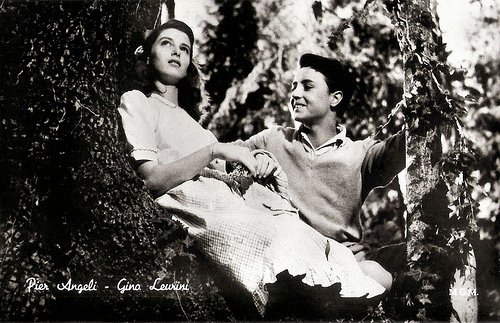
Pier Angeli and Gino Leurini in Domani è troppo tardi/Tomorrow Is Too Late (Léonide Moguy, 1950). Italian postcard. Photo: M.G.M.
Slow starter
Aldo Rossano Graziati was born in Scorzè, Italy in 1905. As a boy, he already loved to travel and in 1923 he moved to France to become an actor.
Aldo worked on stage and began his film career as a supporting actor in the French silent film L'ile d'amour/The Island of Love (Berthe Dagmar, Jean Durand, 1929), credited as Aldo Rossano. But soon he gave up this profession.
He kept his hand in the film business, and became a still photographer. He kept this position for nearly 20 years. He made the stills for such classics of the French cinema as L'éternel retour (Jean Delannoy, 1943) with Madeleine Sologne and Jean Marais , La vie de bohème (Marcel L'Herbier, 1945) starring Maria Denis and Louis Jourdan , and the romantic fantasy La belle et la bête (Jean Cocteau, 1946) with Jean Marais and Josette Day .
His eye was always on becoming a cinematographer and he worked his way up to assistant cameraman. Then the slow starter became the camera operator for such French films as L'empreinte du Dieu/Two Women (Léonide Moguy, 1940) with Pierre Blanchar , and La symphonie fantastique/The Fantastic Symphony (Christian-Jacque, 1942) with Renée Saint-Cyr .
In the early 1940s, Aldo alternated the work of camera operator (often with Roger Hubert) to work as a portrait photographer for the well-known Studio Harcourt in Paris, for which Cecil Beaton and Paul Ronald also worked. He also worked for Discina. His stills and portraits show a flair for aesthetic shots and his admiration for Caravaggio. In his later camera work for La Terra Trema (1948) this influence is also recognizable.
Finally he secured the position of full-fledged cinematographer. According to Wikipedia , his first feature as a cinematographer was La Chartreuse de Parme/The Charterhouse of Parma (Christian-Jaque, 1948), starring Gérard Philipe and Maria Casares. However, IMDb credits him as the still photographer at that film.
When the Nazis occupied France, he fled to Nice. There he met Michelangelo Antonioni, who brought him back to Italy. Antonio introduced him to his friend Luchino Visconti, who asked him to undertake the photography for La Terra Trema (1948). Thus Aldo became a key figure in the neorealist cinema.
According to Albert Steeman at the Internet Encyclopedia of Cinematographers , Aldo "created some of the most influential black-and-white films of his time. He is, in many opinions, the greatest among the neorealist cinematographers, and his most miraculous achievement was to respect and portray the reality of life by maximizing the potential of the camera and lights."
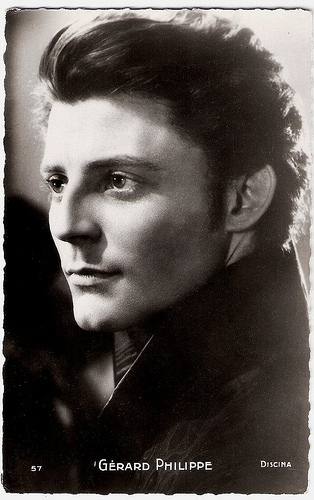
Gérard Philipe . French postcard by Editions P.I., Paris, no. 57. Photo: Discina.
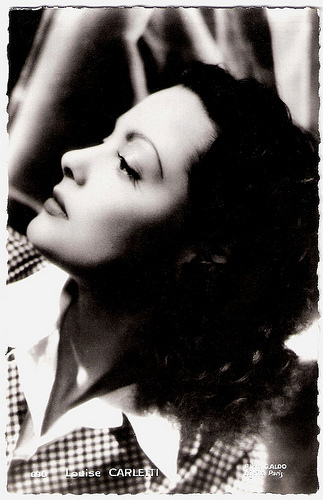
Louise Carletti. French postcard by Collection Chantal, no. 838. Photo: G. Aldo / Discina, Paris.
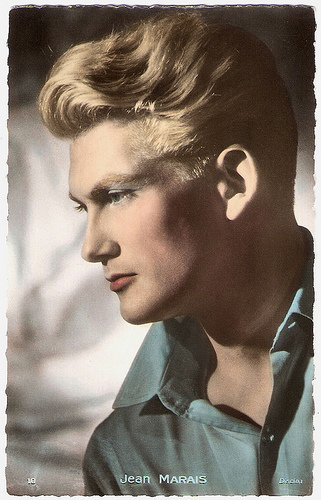
Jean Marais . French postcard by Editions E.C., Paris, no. 10. Photo: Discina.
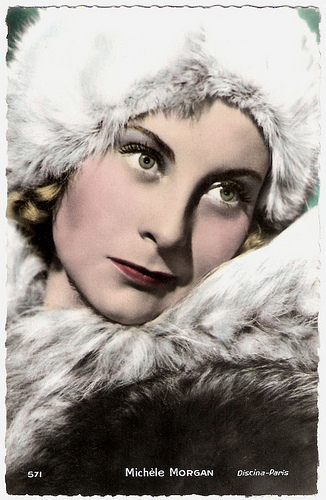
Michèle Morgan . French postcard by Edit. Chantal, Rueil, no. 571. Photo: Discina, Paris.
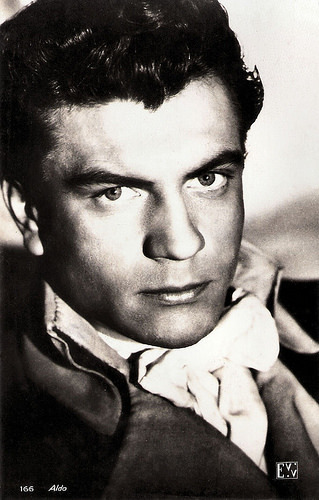
Henri Vidal . French postcard by Editions Votre Vedette (EVV), no. 166. Photo: Aldo Graziati.
Check out our other posts on film star photographers. See the links at right under the caption 'The Photographers'.
Sources: Albert Steeman (Internet Encyclopedia of Cinematographers), Wikipedia (English and German) and .

Alain Cuny . French postcard by E.C. Paris, no. 58. Photo: Aldò Graziati / Discina. Publicity still for Les visiteurs du soir (Marcel Carné, 1942).
Visconti
During his career as an actor, photographer, cameras operator and cinematographer Aldo Rossano Graziati was credited as Aldo Rossano, Aldo, G. Aldo and G.R. Aldo.
In 1947, he shot his first film, the short French documentary Couleur de Venise/Colour of Venice (Jean Faurez, Jacques Mercanton, 1947).
A year later, he worked with Luchino Visconti on the neorealist classic La Terra Trema/The Earth Trembles (Luchino Visconti, 1948), loosely adapted from Giovanni Verga's novel I Malavoglia (The House by the Medlar Tree).
The picture, a docufiction about the exploitation of working-class fishermen on Sicily, features non-professional actors, including the brothers Antonio Arcidiacono and Giuseppe Arcidiacono.
Aldo's sensitivity to location in this drama of poor Sicilian fishermen produced never-to-be-forgotten images in black-and-white. The physical beauty of the sea scenes and the contrasting landscapes never obscured the neorealistic approach of its director. La Terra Trema/The Earth Trembles received a Golden Lion at the 9th Venice International Film Festival in 1948.
Aldo was also the cinematographer of the Italian historical drama Cielo sulla palude/Heaven over the Marshes (Augusto Genina, 1949) portraying the life of the saint Maria Goretti, and the drama Domani è troppo tardi/Tomorrow Is Too Late (Léonide Moguy, 1950) with Pier Angeli . The film was awarded Best Italian Film at the Venice Film Festival.
Aldo worked three times for director Vittorio De Sica as the cinematographer of Miracolo a Milano/Miracle in Milan (Vittorio de Sica, 1951), the neorealist classic Umberto D. (Vittorio de Sica, 1952), and Stazione Termini/Indiscretion of an American Wife (Vittorio de Sica, 1953), starring Jennifer Jones and Montgomery Clift.
He also worked as one of the cinematographers of Orson Welles ' mythical Othello (1952). The film won the Best film award at the Cannes Film Festival in 1952.
Aldo's final film was the drama Senso (Luchino Visconti, 1954) with Alida Valli and Farley Granger. Senso was Visconti's and Aldo's first colour film and they obviously had put a lot of effort to it. Senso is visually gorgeous and meant an aesthetic revolution for Italian cinema.
During the production of the film, Aldo was killed in a car crash in Albara di Pianiga near Padua on 14 November 1953. British cinematographer Robert Krasker completed the film.
Aldo's cinematography for the film later received the Italian National Syndicate of Film Journalists' award. Visconti was nominated for the Golden Lion award at the 15th Venice International Film Festival.

Pier Angeli and Gino Leurini in Domani è troppo tardi/Tomorrow Is Too Late (Léonide Moguy, 1950). Italian postcard. Photo: M.G.M.
Slow starter
Aldo Rossano Graziati was born in Scorzè, Italy in 1905. As a boy, he already loved to travel and in 1923 he moved to France to become an actor.
Aldo worked on stage and began his film career as a supporting actor in the French silent film L'ile d'amour/The Island of Love (Berthe Dagmar, Jean Durand, 1929), credited as Aldo Rossano. But soon he gave up this profession.
He kept his hand in the film business, and became a still photographer. He kept this position for nearly 20 years. He made the stills for such classics of the French cinema as L'éternel retour (Jean Delannoy, 1943) with Madeleine Sologne and Jean Marais , La vie de bohème (Marcel L'Herbier, 1945) starring Maria Denis and Louis Jourdan , and the romantic fantasy La belle et la bête (Jean Cocteau, 1946) with Jean Marais and Josette Day .
His eye was always on becoming a cinematographer and he worked his way up to assistant cameraman. Then the slow starter became the camera operator for such French films as L'empreinte du Dieu/Two Women (Léonide Moguy, 1940) with Pierre Blanchar , and La symphonie fantastique/The Fantastic Symphony (Christian-Jacque, 1942) with Renée Saint-Cyr .
In the early 1940s, Aldo alternated the work of camera operator (often with Roger Hubert) to work as a portrait photographer for the well-known Studio Harcourt in Paris, for which Cecil Beaton and Paul Ronald also worked. He also worked for Discina. His stills and portraits show a flair for aesthetic shots and his admiration for Caravaggio. In his later camera work for La Terra Trema (1948) this influence is also recognizable.
Finally he secured the position of full-fledged cinematographer. According to Wikipedia , his first feature as a cinematographer was La Chartreuse de Parme/The Charterhouse of Parma (Christian-Jaque, 1948), starring Gérard Philipe and Maria Casares. However, IMDb credits him as the still photographer at that film.
When the Nazis occupied France, he fled to Nice. There he met Michelangelo Antonioni, who brought him back to Italy. Antonio introduced him to his friend Luchino Visconti, who asked him to undertake the photography for La Terra Trema (1948). Thus Aldo became a key figure in the neorealist cinema.
According to Albert Steeman at the Internet Encyclopedia of Cinematographers , Aldo "created some of the most influential black-and-white films of his time. He is, in many opinions, the greatest among the neorealist cinematographers, and his most miraculous achievement was to respect and portray the reality of life by maximizing the potential of the camera and lights."

Gérard Philipe . French postcard by Editions P.I., Paris, no. 57. Photo: Discina.

Louise Carletti. French postcard by Collection Chantal, no. 838. Photo: G. Aldo / Discina, Paris.

Jean Marais . French postcard by Editions E.C., Paris, no. 10. Photo: Discina.

Michèle Morgan . French postcard by Edit. Chantal, Rueil, no. 571. Photo: Discina, Paris.

Henri Vidal . French postcard by Editions Votre Vedette (EVV), no. 166. Photo: Aldo Graziati.
Check out our other posts on film star photographers. See the links at right under the caption 'The Photographers'.
Sources: Albert Steeman (Internet Encyclopedia of Cinematographers), Wikipedia (English and German) and .
Published on January 20, 2015 22:00
January 19, 2015
Harry Halm
Charming actor Harry Halm (1901-1980) was a popular ladies’ man of the silent German cinema. Sound film and the rise of the Nazis broke his career.
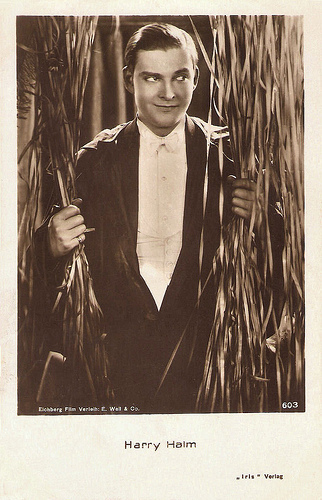
Austrian postcard by Iris Verlag, no. 603. Photo: Eichberg Film / Verleih: E. Weil & Co.
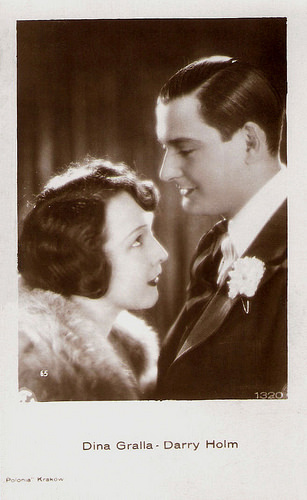
Polish postcard by Polonia, Krakow, no. 1320. Publicity still for Prinzessin Trulala/Princess Trulala (Erich Schönfelder, Richard Eichberg, 1926) with Dina Gralla .
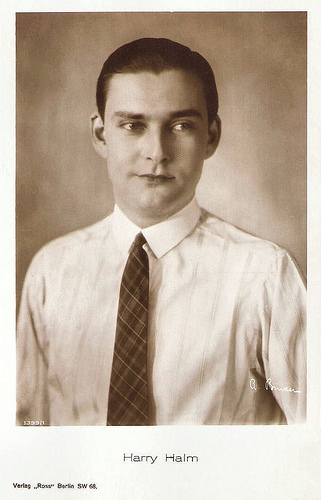
German postcard by Ross Verlag, no. 1399/1, 1927-1928. Photo: Alex Binder.
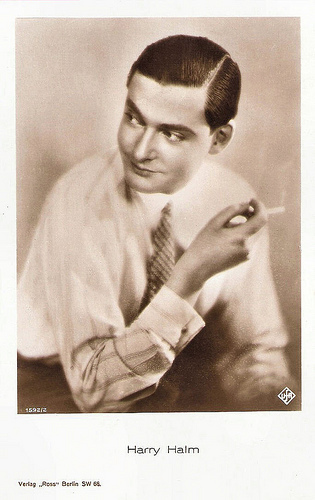
German postcard by Ross Verlag, no. 1592/2, 1927-1928. Photo: Ufa.
Dapper Charmer
Harry Halm was born in Berlin in 1901 (some sources say 1902). He was the son of the theatre manager and film director Alfred Halm.
He took acting lessons with Eduard von Winterstein and Hermann Vallentin and he began his stage career at the Schauspielhaus in Potsdam in 1919. After this engagement he went to Hamburg and later to Berlin.
Halm made his first film appearance in his father’s Der galante König/The Galant King (Alfred Halm, 1920). Two years later his father directed him again in Freund Ripp/Friend Ripp (Alfred Halm, 1923) starring Käthe Haack .
From 1923 on, he appeared more regularly before the camera in such films as Der Evangelimann/The Evangelist (Holger-Madsen, 1923) with Paul Hartmann , Windstärke 9. Die Geschichte einer reichen Erbin/Wind-force 9 – the Story of a Heir (Reinhold Schünzel, 1924) with Alwin Neuss, and Kammermusik/Chamber music (Carl Froelich, 1925) starring Henny Porten .
His most popular films included Der Demütige und die Tänzerin/The humble man and the dancer (Ewald André Dupont, 1925) with Lil Dagover , Moral/Morality (Willi Wolff, 1927) with Ellen Richter , and Die blaue Maus/The Blue Mouse (Johannes Guter, 1928) with Jenny Jugo . He was given leading roles in these films as a dapper charmer and ladies' man.
The young Lilian Harvey was in Die tolle Lola/Fabulous Lola (Richard Eichberg, 1927), Ihr dunkler Punkt/Her Skeleton in the Closet (Johannes Guter, 1929), and many other Ufa productions his partner.
He also appeared in Jennys Bummel durch die Männer/Jenny's stroll by the men (Jaap Speyer, 1929) opposite Dutch film star Truus van Aalten . This Terra-film comedy was directed by Dutchman Jaap Speyer and partially filmed in the Netherlands at the beach of Scheveningen. Most of Halm’s silent films were popular, although they were not particularly striking.
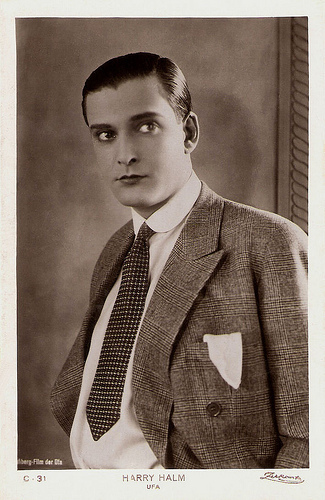
Spanish postcard by Zerkowska / IFG, no. C - 31. Photo: Ufa.
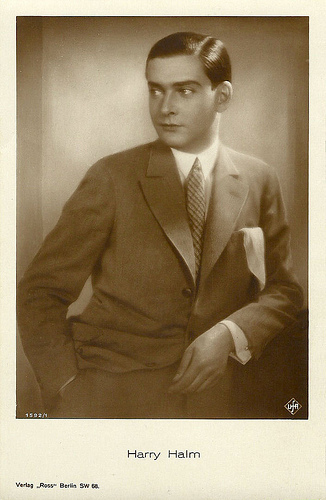
German postcard by Ross Verlag, no. 1592/1, 1927-1928. Photo: Ufa. Collection: Didier Hanson.
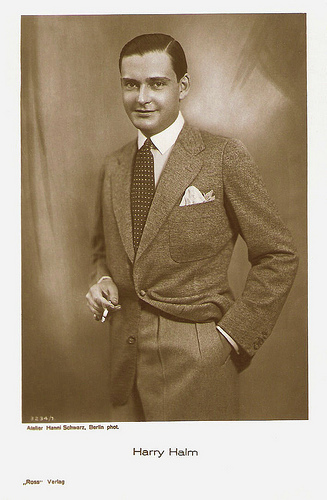
German postcard by Ross Verlag, no. 3234/1, 1928-1929. Photo: Hanni Schwarz.
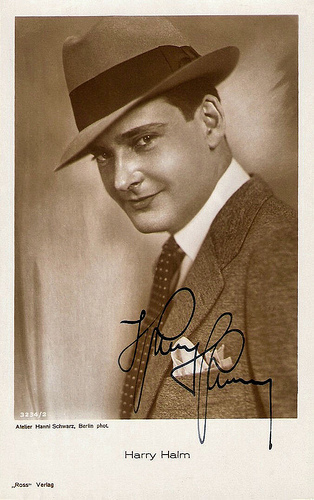
German postcard by Ross Verlag, no. 3234/2, 1928-1929. Photo: Hanni Schwarz, Berlin.
Disappeared
In the sound film era, Harry Halm was only offered supporting roles. At the beginning of the 1930s he appeared in supporting parts in the talkies Hokuspokus/Hocuspocus (Gustav Ucicky, 1930) with Willy Fritsch and Lilian Harvey , Der wahre Jakob/True Jacob (Hans Steinhoff, 1931), and Ein toller Einfall/A Mad Idea (Kurt Gerron, 1932).
After the takeover of the Nazis in 1933, he was not even considered at all by Ufa and the other studios. He disappeared completely from the screen. The reason for this is unclear.
Only after the Second World War he returned to the cinema. He suddenly turned up in the Austrian film comedies Die Welt dreht sich verkehrt/The World Turns Backward (J.A. Hübler-Kahla, 1947) with Hans Moser , and Hin und her/Back and forth (Theo Lingen, 1948).
Halm wrote the screenplay for the film operetta Im weissen Rössl/The White Horse Inn (Willi Forst, 1952) starring Johanna Matz and Johannes Heesters .
He made some sporadic appearances in such films as Die Försterchristl/The Forester's Daughter (Arthur Maria Rabenalt, 1952) and Alraune/Mandrake (Arthur Maria Rabenalt, 1952) starring Hildegard Knef and Erich von Stroheim .
In 1955 he directed the short documentary Erfolg am laufenden Band/Success continuously (1956). His last contribution to the cinema was a small part in Der kühne Schwimmer/The bold swimmer (Karl Anton, 1957) starring Gunther Philipp and Susanne Cramer .
During the 1960s he appeared a few times on German television, including a guest role in the Krimi series Das Kriminalmuseum/The criminal museum (1963-1970).
Harry Halm died in 1980 in Munich. He was 79.
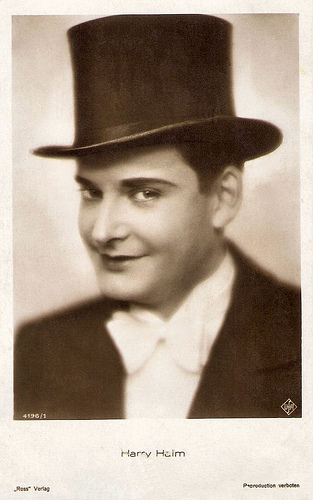
German postcard by Ross Verlag, no. 4196/1, 1929-1930. Photo: Ufa.
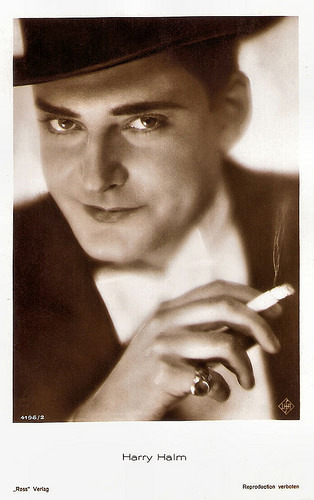
German postcard by Ross Verlag, no. 4196/2, 1929-1930. Photo: Ufa.
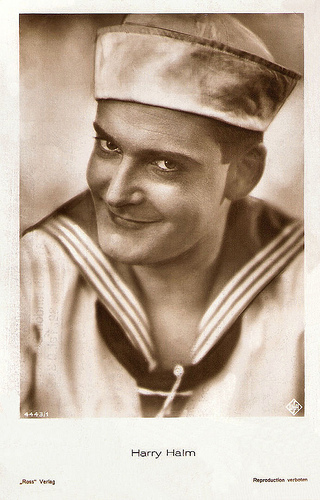
German postcard by Ross Verlag, no. 4443/1, 1929-1930. Photo: Ufa. Harry Halm in the German early sound film Wenn du einmal dein Herz verschenkst/When You One Day Give Your Heart Away (Johannes Guter, 1929) starring Halm, Igo Sym and Lilian Harvey .
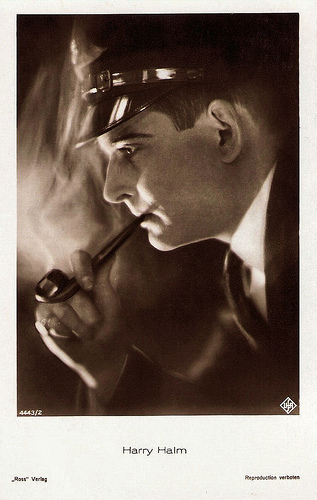
German postcard by Ross Verlag, no. 4443/2, 1929-1930. Photo: Ufa.
Sources: Thomas Staedeli (Cyranos), Filmportal.de, Wikipedia (German) and .

Austrian postcard by Iris Verlag, no. 603. Photo: Eichberg Film / Verleih: E. Weil & Co.

Polish postcard by Polonia, Krakow, no. 1320. Publicity still for Prinzessin Trulala/Princess Trulala (Erich Schönfelder, Richard Eichberg, 1926) with Dina Gralla .

German postcard by Ross Verlag, no. 1399/1, 1927-1928. Photo: Alex Binder.

German postcard by Ross Verlag, no. 1592/2, 1927-1928. Photo: Ufa.
Dapper Charmer
Harry Halm was born in Berlin in 1901 (some sources say 1902). He was the son of the theatre manager and film director Alfred Halm.
He took acting lessons with Eduard von Winterstein and Hermann Vallentin and he began his stage career at the Schauspielhaus in Potsdam in 1919. After this engagement he went to Hamburg and later to Berlin.
Halm made his first film appearance in his father’s Der galante König/The Galant King (Alfred Halm, 1920). Two years later his father directed him again in Freund Ripp/Friend Ripp (Alfred Halm, 1923) starring Käthe Haack .
From 1923 on, he appeared more regularly before the camera in such films as Der Evangelimann/The Evangelist (Holger-Madsen, 1923) with Paul Hartmann , Windstärke 9. Die Geschichte einer reichen Erbin/Wind-force 9 – the Story of a Heir (Reinhold Schünzel, 1924) with Alwin Neuss, and Kammermusik/Chamber music (Carl Froelich, 1925) starring Henny Porten .
His most popular films included Der Demütige und die Tänzerin/The humble man and the dancer (Ewald André Dupont, 1925) with Lil Dagover , Moral/Morality (Willi Wolff, 1927) with Ellen Richter , and Die blaue Maus/The Blue Mouse (Johannes Guter, 1928) with Jenny Jugo . He was given leading roles in these films as a dapper charmer and ladies' man.
The young Lilian Harvey was in Die tolle Lola/Fabulous Lola (Richard Eichberg, 1927), Ihr dunkler Punkt/Her Skeleton in the Closet (Johannes Guter, 1929), and many other Ufa productions his partner.
He also appeared in Jennys Bummel durch die Männer/Jenny's stroll by the men (Jaap Speyer, 1929) opposite Dutch film star Truus van Aalten . This Terra-film comedy was directed by Dutchman Jaap Speyer and partially filmed in the Netherlands at the beach of Scheveningen. Most of Halm’s silent films were popular, although they were not particularly striking.

Spanish postcard by Zerkowska / IFG, no. C - 31. Photo: Ufa.

German postcard by Ross Verlag, no. 1592/1, 1927-1928. Photo: Ufa. Collection: Didier Hanson.

German postcard by Ross Verlag, no. 3234/1, 1928-1929. Photo: Hanni Schwarz.

German postcard by Ross Verlag, no. 3234/2, 1928-1929. Photo: Hanni Schwarz, Berlin.
Disappeared
In the sound film era, Harry Halm was only offered supporting roles. At the beginning of the 1930s he appeared in supporting parts in the talkies Hokuspokus/Hocuspocus (Gustav Ucicky, 1930) with Willy Fritsch and Lilian Harvey , Der wahre Jakob/True Jacob (Hans Steinhoff, 1931), and Ein toller Einfall/A Mad Idea (Kurt Gerron, 1932).
After the takeover of the Nazis in 1933, he was not even considered at all by Ufa and the other studios. He disappeared completely from the screen. The reason for this is unclear.
Only after the Second World War he returned to the cinema. He suddenly turned up in the Austrian film comedies Die Welt dreht sich verkehrt/The World Turns Backward (J.A. Hübler-Kahla, 1947) with Hans Moser , and Hin und her/Back and forth (Theo Lingen, 1948).
Halm wrote the screenplay for the film operetta Im weissen Rössl/The White Horse Inn (Willi Forst, 1952) starring Johanna Matz and Johannes Heesters .
He made some sporadic appearances in such films as Die Försterchristl/The Forester's Daughter (Arthur Maria Rabenalt, 1952) and Alraune/Mandrake (Arthur Maria Rabenalt, 1952) starring Hildegard Knef and Erich von Stroheim .
In 1955 he directed the short documentary Erfolg am laufenden Band/Success continuously (1956). His last contribution to the cinema was a small part in Der kühne Schwimmer/The bold swimmer (Karl Anton, 1957) starring Gunther Philipp and Susanne Cramer .
During the 1960s he appeared a few times on German television, including a guest role in the Krimi series Das Kriminalmuseum/The criminal museum (1963-1970).
Harry Halm died in 1980 in Munich. He was 79.

German postcard by Ross Verlag, no. 4196/1, 1929-1930. Photo: Ufa.

German postcard by Ross Verlag, no. 4196/2, 1929-1930. Photo: Ufa.

German postcard by Ross Verlag, no. 4443/1, 1929-1930. Photo: Ufa. Harry Halm in the German early sound film Wenn du einmal dein Herz verschenkst/When You One Day Give Your Heart Away (Johannes Guter, 1929) starring Halm, Igo Sym and Lilian Harvey .

German postcard by Ross Verlag, no. 4443/2, 1929-1930. Photo: Ufa.
Sources: Thomas Staedeli (Cyranos), Filmportal.de, Wikipedia (German) and .
Published on January 19, 2015 22:00
January 18, 2015
Brian Aherne
British stage and screen actor Brian Aherne (1902-1986) was one of the top character actors of Hollywood in the 1930s, 1940s and 1950s. He was Oscar-nominated for Juarez (1939).
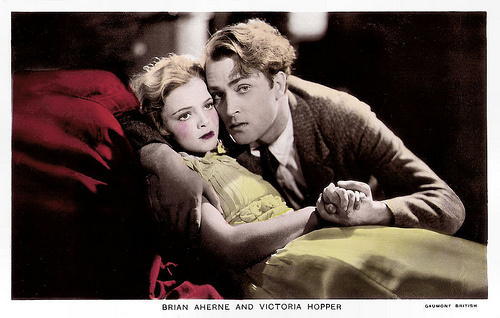
British Real Photograph postcard in the Film Partners series, no. P 121. Photo: Gaumont-British. Publicity still for The Constant Nymph (Basil Dean, 1933) with Victoria Hopper.
The next best thing
Brian Aherne was born William Brian de Lacy Aherne in King's Norton, Worcestshire, England, in 1902. He was the son of the Birmingham architect William de Lacy Aherne and his wife Louise née Thomas. His brother was actor Patrick Aherne.
Brian was educated in Edgbaston, Birmingham, England and at Malvern College, Worcestershire. As a child he trained at the Italia Conti's School in London, and only 9, he made his stage debut in Birmingham. At age 18 he made his debut as an adult with the with the Pilgrim Players which would evolve into the famous Birmingham Repertory Theatre.
Three years later, he made his debut in London's West End. Then, Aherne studied architecture, but a life as an actor was too strong to resist, so he returned to the theatre in 1923 for the revival of Paddy the Next Best Thing at the Savoy Theatre, London. For the next eight years, he toured the provinces and appeared in various productions in the West End.
In 1924, he made his film debut in the British crime drama The Eleventh Commandment (George A. Cooper, 1924) with Fay Compton, Stewart Rome and Lillian Hall-Davis . In the following years he appeared in such films as the romantic dramas The Squire of Long Hadley (Sinclair Hill, 1925) and King of the Castle (Henry Edwards, 1925) both with Marjorie Hume.
In the comedy Safety First (Fred Paul, 1926), he played a man who has his friends pose as asylum inmates to fool his rich aunt. One of his best silent British films was Shooting Stars (Anthony Asquith, A.V. Bramble, 1928) in which his adulterous wife ( Annette Benson ) hatches a plot to kill him. Elissa Landi was his co-star in Underground (Anthony Asquith, 1928), a working-class love story set in and around the London Underground of the 1920s.
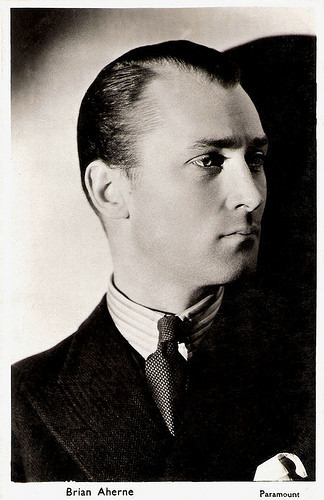
British Real Photograph postcard. Photo: Paramount.
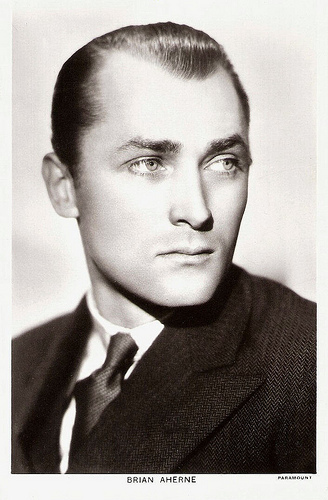
British postcard in the Picturegoer Series, London, no. 401b. Photo: Paramount.
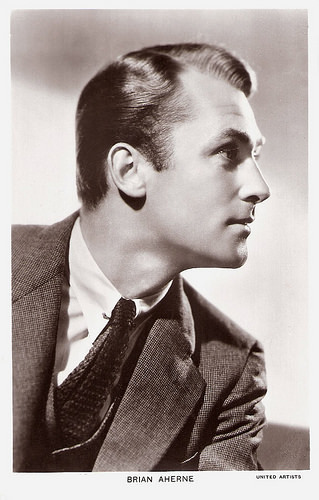
British Real Photograph postcard in the Picturegoer Series, no. 401 C. Photo: United Artists.
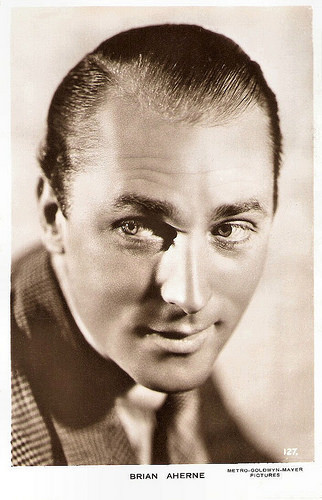
British Real Photograph postcard, no. 127. Photo: Metro-Goldwyn-Mayer.
A proper job
In 1931, Brian Aherne made his Broadway debut playing Robert Browning in The Barretts of Wimpole Street. His sound film debut was Madame Guillotine (1931). He alternated between the New York and London stage in the early 1930s. Then he moved to Hollywood.
His first role was as Marlene Dietrich ’s love interest in Song of Songs (Rouben Mamoulian, 1933). In Britain, he appeared in The Constant Nymph (Basil Dean, 1933).
He co-starred with Katherine Hepburn and Cary Grant in Sylvia Scarlett (George Cukor, 1935) and opposite Merle Oberon and David Niven in Beloved Enemy (H.C. Potter, 1936).
Aherne embodied the legendary British stage actor David Garrick in James Whale’s The Great Garrick (1937) opposite the young Olivia De Havilland. Next he made the romantic comedy Merrily We Live (Norman Z. MacLeod, 1938) in which he starred as an intelligent tramp hired as a chauffeur by a wealthy family.
In Juarez (William Dieterle, 1939) he played the doomed Emperor Maximillian. For this part, he was nominated for an Academy Award as Best Supporting Actor in 1940.
During the 1940s he starred in popular films like the screwball comedy My Sister Eileen (Alexander Hall, 1942) with Rosalind Russell, and the entertaining propaganda film Forever and a Day (Edmund Goulding, Cedric Hardwicke, et al, 1943).
In 1945, he travelled to Italy, France, Holland, and Germany to perform for the troops in The Barretts of Wimpole Street. He returned to play supporting roles in Hollywood films as the Film Noir The Locke (John Brahm, 1946) starring Robert Mitchum, and Alfred Hitchcock’s thriller I Confess (1953) starring Montgomery Clift.
His final film was Rosie! (David Lowell Rich, 1967) in which he was reunited with Rosalind Russell. Brian Aherne published his autobiography A Proper Job in 1969, and 10 years later, he published a biography of his friend George Sanders, entitled A Dreadful Man.
In 1986, Brian Aherne died of heart failure in Venice, Florida at the age of 83. He was married twice. His first wife was actress Joan Fontaine (1939-1945) (divorced). In 1946, he married Eleanor de Liagre Labrot, with whom he stayed till his death.
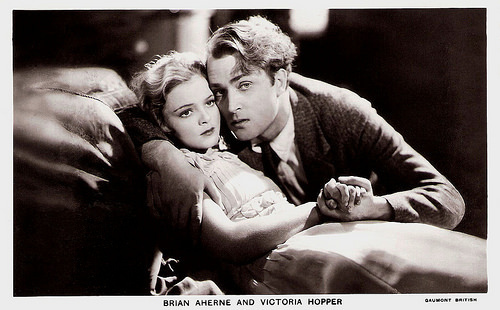
British Real Photograph postcard in the Film Partners series, no. P 121. Photo: Gaumont-British. Publicity still for The Constant Nymph (Basil Dean, 1933).
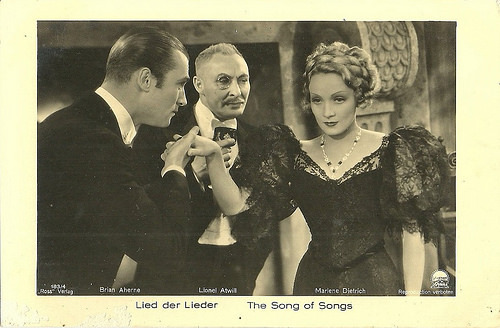
German postcard by Ross Verlag, no. 183/4. Photo: Paramount. Publicity still of Brian Aherne (Richard), Lionel Atwill (Baron von Merzbach) and Marlene Dietrich (Lily) in Song of Songs (Rouben Mamoulian, 1933). Dietrich is a naïve peasant girl who models (naked) for a sculptor and falls in love with him. A rich baron, the sculptor's client, presses the artist to leave the girl to him. The baron turns her into a lady, but, incidentally, in a world wise woman too. He invites the sculptor to show Lily's metamorphosis. Lily is terribly hurt by both men.
Sources: (IMDb), Wikipedia, and .

British Real Photograph postcard in the Film Partners series, no. P 121. Photo: Gaumont-British. Publicity still for The Constant Nymph (Basil Dean, 1933) with Victoria Hopper.
The next best thing
Brian Aherne was born William Brian de Lacy Aherne in King's Norton, Worcestshire, England, in 1902. He was the son of the Birmingham architect William de Lacy Aherne and his wife Louise née Thomas. His brother was actor Patrick Aherne.
Brian was educated in Edgbaston, Birmingham, England and at Malvern College, Worcestershire. As a child he trained at the Italia Conti's School in London, and only 9, he made his stage debut in Birmingham. At age 18 he made his debut as an adult with the with the Pilgrim Players which would evolve into the famous Birmingham Repertory Theatre.
Three years later, he made his debut in London's West End. Then, Aherne studied architecture, but a life as an actor was too strong to resist, so he returned to the theatre in 1923 for the revival of Paddy the Next Best Thing at the Savoy Theatre, London. For the next eight years, he toured the provinces and appeared in various productions in the West End.
In 1924, he made his film debut in the British crime drama The Eleventh Commandment (George A. Cooper, 1924) with Fay Compton, Stewart Rome and Lillian Hall-Davis . In the following years he appeared in such films as the romantic dramas The Squire of Long Hadley (Sinclair Hill, 1925) and King of the Castle (Henry Edwards, 1925) both with Marjorie Hume.
In the comedy Safety First (Fred Paul, 1926), he played a man who has his friends pose as asylum inmates to fool his rich aunt. One of his best silent British films was Shooting Stars (Anthony Asquith, A.V. Bramble, 1928) in which his adulterous wife ( Annette Benson ) hatches a plot to kill him. Elissa Landi was his co-star in Underground (Anthony Asquith, 1928), a working-class love story set in and around the London Underground of the 1920s.

British Real Photograph postcard. Photo: Paramount.

British postcard in the Picturegoer Series, London, no. 401b. Photo: Paramount.

British Real Photograph postcard in the Picturegoer Series, no. 401 C. Photo: United Artists.

British Real Photograph postcard, no. 127. Photo: Metro-Goldwyn-Mayer.
A proper job
In 1931, Brian Aherne made his Broadway debut playing Robert Browning in The Barretts of Wimpole Street. His sound film debut was Madame Guillotine (1931). He alternated between the New York and London stage in the early 1930s. Then he moved to Hollywood.
His first role was as Marlene Dietrich ’s love interest in Song of Songs (Rouben Mamoulian, 1933). In Britain, he appeared in The Constant Nymph (Basil Dean, 1933).
He co-starred with Katherine Hepburn and Cary Grant in Sylvia Scarlett (George Cukor, 1935) and opposite Merle Oberon and David Niven in Beloved Enemy (H.C. Potter, 1936).
Aherne embodied the legendary British stage actor David Garrick in James Whale’s The Great Garrick (1937) opposite the young Olivia De Havilland. Next he made the romantic comedy Merrily We Live (Norman Z. MacLeod, 1938) in which he starred as an intelligent tramp hired as a chauffeur by a wealthy family.
In Juarez (William Dieterle, 1939) he played the doomed Emperor Maximillian. For this part, he was nominated for an Academy Award as Best Supporting Actor in 1940.
During the 1940s he starred in popular films like the screwball comedy My Sister Eileen (Alexander Hall, 1942) with Rosalind Russell, and the entertaining propaganda film Forever and a Day (Edmund Goulding, Cedric Hardwicke, et al, 1943).
In 1945, he travelled to Italy, France, Holland, and Germany to perform for the troops in The Barretts of Wimpole Street. He returned to play supporting roles in Hollywood films as the Film Noir The Locke (John Brahm, 1946) starring Robert Mitchum, and Alfred Hitchcock’s thriller I Confess (1953) starring Montgomery Clift.
His final film was Rosie! (David Lowell Rich, 1967) in which he was reunited with Rosalind Russell. Brian Aherne published his autobiography A Proper Job in 1969, and 10 years later, he published a biography of his friend George Sanders, entitled A Dreadful Man.
In 1986, Brian Aherne died of heart failure in Venice, Florida at the age of 83. He was married twice. His first wife was actress Joan Fontaine (1939-1945) (divorced). In 1946, he married Eleanor de Liagre Labrot, with whom he stayed till his death.

British Real Photograph postcard in the Film Partners series, no. P 121. Photo: Gaumont-British. Publicity still for The Constant Nymph (Basil Dean, 1933).

German postcard by Ross Verlag, no. 183/4. Photo: Paramount. Publicity still of Brian Aherne (Richard), Lionel Atwill (Baron von Merzbach) and Marlene Dietrich (Lily) in Song of Songs (Rouben Mamoulian, 1933). Dietrich is a naïve peasant girl who models (naked) for a sculptor and falls in love with him. A rich baron, the sculptor's client, presses the artist to leave the girl to him. The baron turns her into a lady, but, incidentally, in a world wise woman too. He invites the sculptor to show Lily's metamorphosis. Lily is terribly hurt by both men.
Sources: (IMDb), Wikipedia, and .
Published on January 18, 2015 22:00
January 17, 2015
Cornell Borchers
In 1948 Cornell Borchers (1925-2014) started her film career in the post-war German cinema. She had her international breakthrough with her third film, The Big Lift (1950) starring Montgomery Clift. The tall, blonde, turquoise-eyed actress went on to work in England and in Hollywood, where she starred for Universal in films opposite Rock Hudson and Errol Flynn. At the end of the 1950s, she retired from acting to raise her daughter.
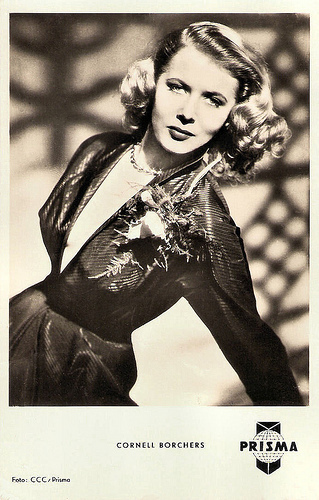
German postcard by Kunst und Bild, Berlin, no. A428. Photo: CCC / Prisma.
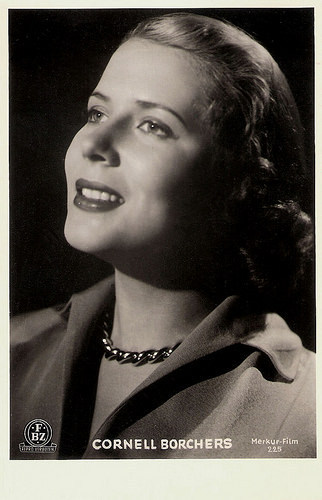
German postcard by FBZ, no. 225. Photo: Merkur-Film. Publicity still for Das ewige Spiel/The eternal game (Frantisek Cáp, 1951).
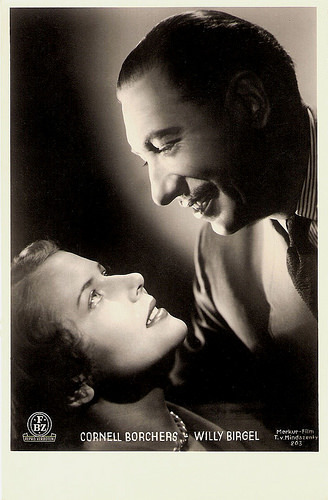
German postcard by FBZ, no. 225. Photo: Merkur-Film / T. v. Mindszenty. Publicity still for Das ewige Spiel/The eternal game (Frantisek Cáp, 1951) with Willy Birgel .
Berlin Airlift
Cornell Borchers was born as Cornelia Bruch in Heydekrug (now Silute) in former East Prussia (now Lithuania) in 1925. She first studied medicine at the Universität Göttingen for two semesters before she attended drama classes in 1947 and 1948.
In 1948 she was discovered by film director Arthur Maria Rabenalt. Borchers debuted in his Anonyme Briefe/Anonymous Letters (1949) and also appeared in his Martina (1949).
She then signed a seven-year contract with 20th Century Fox. Publicity quickly touted her as 'the new Ingrid Bergman ', but her first Hollywood sojourn turned out to be rather brief.
Her first film was the American-German coproduction The Big Lift (George Seaton, 1951). It tells the story of 'Operation Vittles', the 1948–1949 Berlin Airlift because of the Soviet blockade of Berlin, through the experiences of two U.S. Air Force sergeants (Montgomery Clift and Paul Douglas). The film was photographed at the real locations. Borchers played a German girl who had a doomed love affair with Montgomery Clift.
After The Big Lift (1950), Borchers walked out on her contract with 20th Century Fox, convinced that quality roles were not forthcoming. She returned to Germany, where she appeared in a series of forgettable crime dramas and romances. Then she got a new chance.
In the British drama The Divided Heart (Charles Crichton, 1954), she and Armin Dahlen play a childless couple in Germany who adopt a young child, whose mother (Yvonne Mitchell) has disappeared during the war. When the boy is 10 years old, his natural mother is found alive in Yugoslavia where she has survived the war as a refugee. She returns to Germany to claim her child, having lost her husband and two other children in the war.
The Divided Heart was a popular and critical success, being highly praised for its sensitivity, emotional impact and the even-handedness with which it dealt with its subject matter. It won three British Academy Film Awards (BAFTA's), including one for Borchers in the category of Best Foreign Actress.
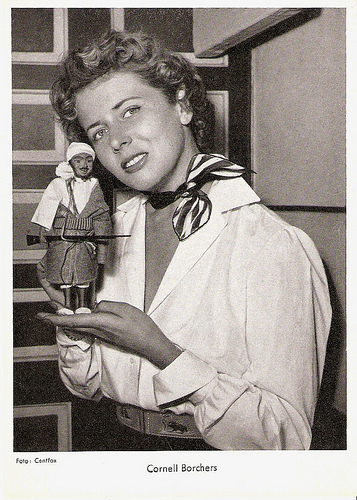
German card. Photo: 20th Century Fox.
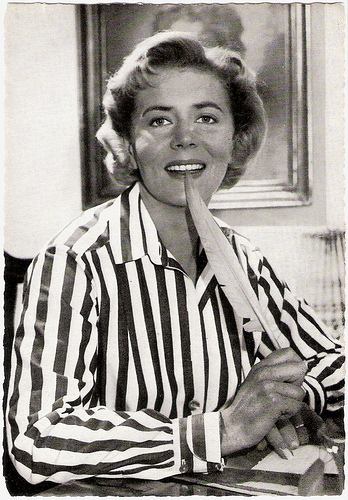
German postcard by WS-Druck, Wanne-Eickel, no. 224. Photo: Ringpress / Vogelmann.
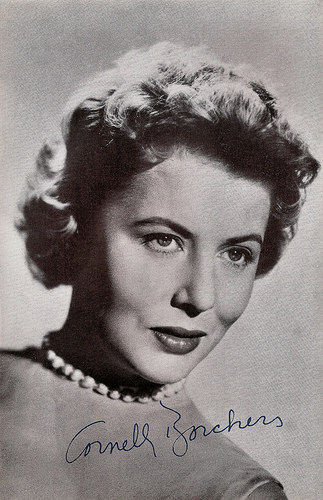
British postcard in the Celebrity Autograph Series, no. 255, by Celebrity Publishers Ltd., London. Photo: Universal-International. Publicity still for Istanbul (Joseph Pevney, 1957).
Heimatfilm
Cornell Borchers married twice, first to the Brit Bruce Cunningham and later to Dr. Anton Schelkopf, a psychologist and film producer/director whom she had met when she starred in his comedy Schule für Eheglück/School for Connubial Bliss (Rainer Geis, Anton Schelkopf, 1954).
Together they also made the Heimatfilm Rot ist die Liebe/Love is Red (Karl Hartl, 1957), in which she starred opposite Dieter Borsche .
She returned to Hollywood. For Universal, she starred opposite Rock Hudson in the romance Never Say Goodbye (Jerry Hopper, 1956), and with Errol Flynn and Nat King Cole in the adventure-drama Istanbul (Joseph Pevney, 1957). I.S. Mowis at IMDb : "Her swan song was an undistinguished social drama entitled Flood Tide (1958), a misfire, which resulted in Universal failing to renew her contract."
Her last film was the German film Arzt ohne Gewissen/Doctor Without Scruples (Falk Harnack, 1959) starring Ewald Balser.
Then she retired from acting and raised her three children: Christian Amadeus (1953), with Bruce Cunningham; Gabriel Antonius (1961) and Julia Kathrin (1962), with Anton Schelkopf.,
Cornell Borchers later divorced Schelkopf and lived quietly at the Starnberger See in Bavaria. There she died on 12 May 2014. She was 89.
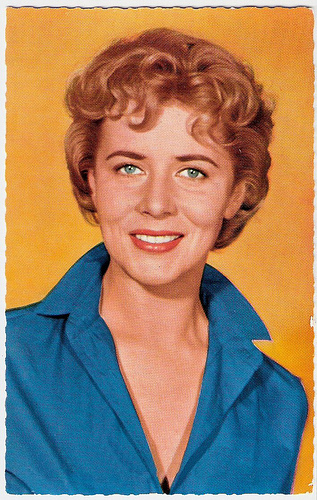
German card by Kolibri-Verlag, Minden (Westf.), no. F 44. Retail price: 25 Pf. Photo: Ringpress / Vogelmann.
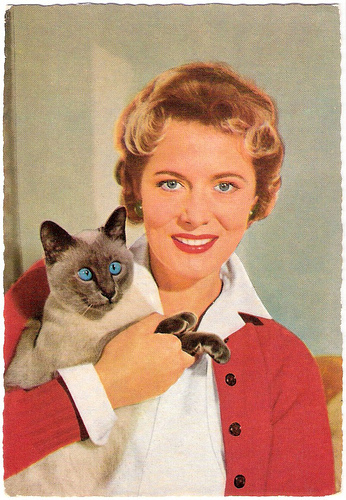
German card by WS-Druck, Wanne-Eickel, no. N.F 3. Photo: Klaus Collignon.
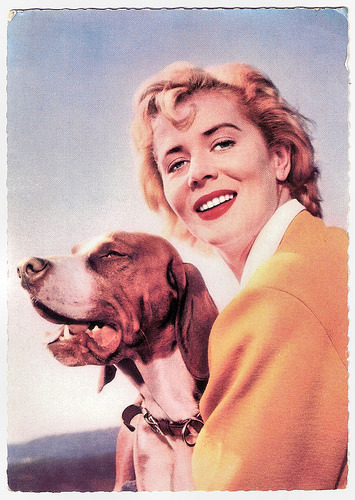
German postcard by ISV, no. L 3. Photo: Klaus Collignon.
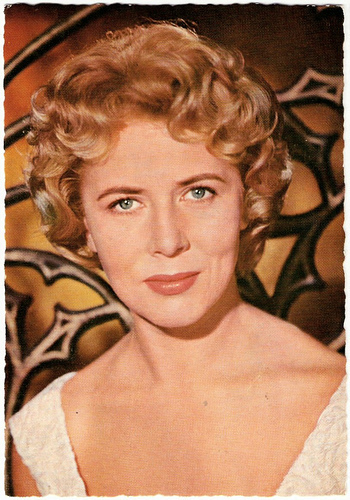
German postcard by WS-Druck, Wanne-Eickel, no. F 52. Photo: Ringpress / Vogelmann / Bavaria.
Sources: (IMDb), Hal Erickson (AllMovie), Sandra Brennan (AllMovie), Wikipedia, and .

German postcard by Kunst und Bild, Berlin, no. A428. Photo: CCC / Prisma.

German postcard by FBZ, no. 225. Photo: Merkur-Film. Publicity still for Das ewige Spiel/The eternal game (Frantisek Cáp, 1951).

German postcard by FBZ, no. 225. Photo: Merkur-Film / T. v. Mindszenty. Publicity still for Das ewige Spiel/The eternal game (Frantisek Cáp, 1951) with Willy Birgel .
Berlin Airlift
Cornell Borchers was born as Cornelia Bruch in Heydekrug (now Silute) in former East Prussia (now Lithuania) in 1925. She first studied medicine at the Universität Göttingen for two semesters before she attended drama classes in 1947 and 1948.
In 1948 she was discovered by film director Arthur Maria Rabenalt. Borchers debuted in his Anonyme Briefe/Anonymous Letters (1949) and also appeared in his Martina (1949).
She then signed a seven-year contract with 20th Century Fox. Publicity quickly touted her as 'the new Ingrid Bergman ', but her first Hollywood sojourn turned out to be rather brief.
Her first film was the American-German coproduction The Big Lift (George Seaton, 1951). It tells the story of 'Operation Vittles', the 1948–1949 Berlin Airlift because of the Soviet blockade of Berlin, through the experiences of two U.S. Air Force sergeants (Montgomery Clift and Paul Douglas). The film was photographed at the real locations. Borchers played a German girl who had a doomed love affair with Montgomery Clift.
After The Big Lift (1950), Borchers walked out on her contract with 20th Century Fox, convinced that quality roles were not forthcoming. She returned to Germany, where she appeared in a series of forgettable crime dramas and romances. Then she got a new chance.
In the British drama The Divided Heart (Charles Crichton, 1954), she and Armin Dahlen play a childless couple in Germany who adopt a young child, whose mother (Yvonne Mitchell) has disappeared during the war. When the boy is 10 years old, his natural mother is found alive in Yugoslavia where she has survived the war as a refugee. She returns to Germany to claim her child, having lost her husband and two other children in the war.
The Divided Heart was a popular and critical success, being highly praised for its sensitivity, emotional impact and the even-handedness with which it dealt with its subject matter. It won three British Academy Film Awards (BAFTA's), including one for Borchers in the category of Best Foreign Actress.

German card. Photo: 20th Century Fox.

German postcard by WS-Druck, Wanne-Eickel, no. 224. Photo: Ringpress / Vogelmann.

British postcard in the Celebrity Autograph Series, no. 255, by Celebrity Publishers Ltd., London. Photo: Universal-International. Publicity still for Istanbul (Joseph Pevney, 1957).
Heimatfilm
Cornell Borchers married twice, first to the Brit Bruce Cunningham and later to Dr. Anton Schelkopf, a psychologist and film producer/director whom she had met when she starred in his comedy Schule für Eheglück/School for Connubial Bliss (Rainer Geis, Anton Schelkopf, 1954).
Together they also made the Heimatfilm Rot ist die Liebe/Love is Red (Karl Hartl, 1957), in which she starred opposite Dieter Borsche .
She returned to Hollywood. For Universal, she starred opposite Rock Hudson in the romance Never Say Goodbye (Jerry Hopper, 1956), and with Errol Flynn and Nat King Cole in the adventure-drama Istanbul (Joseph Pevney, 1957). I.S. Mowis at IMDb : "Her swan song was an undistinguished social drama entitled Flood Tide (1958), a misfire, which resulted in Universal failing to renew her contract."
Her last film was the German film Arzt ohne Gewissen/Doctor Without Scruples (Falk Harnack, 1959) starring Ewald Balser.
Then she retired from acting and raised her three children: Christian Amadeus (1953), with Bruce Cunningham; Gabriel Antonius (1961) and Julia Kathrin (1962), with Anton Schelkopf.,
Cornell Borchers later divorced Schelkopf and lived quietly at the Starnberger See in Bavaria. There she died on 12 May 2014. She was 89.

German card by Kolibri-Verlag, Minden (Westf.), no. F 44. Retail price: 25 Pf. Photo: Ringpress / Vogelmann.

German card by WS-Druck, Wanne-Eickel, no. N.F 3. Photo: Klaus Collignon.

German postcard by ISV, no. L 3. Photo: Klaus Collignon.

German postcard by WS-Druck, Wanne-Eickel, no. F 52. Photo: Ringpress / Vogelmann / Bavaria.
Sources: (IMDb), Hal Erickson (AllMovie), Sandra Brennan (AllMovie), Wikipedia, and .
Published on January 17, 2015 22:00
January 16, 2015
Der brennende Acker (1922)
This week's film special is about the German silent film Der brennende Acker/Burning Soil (Friedrich Wilhelm Murnau, 1922). Murnau shot this drama right before his vampire classic Nosferatu (1922). Der brennende Acker is remarkable for its beautiful exterior shots and its all-star cast, including Vladimir Gajdarov and Lya de Putti. For many decades the film was considered lost, but in 1978 an almost complete print was found in the estate of an Italian priest. There also remains this beautiful series of postcards by Edition de la Cinématographie Française, published for the French release of the film, in France titled La terre qui flambe.
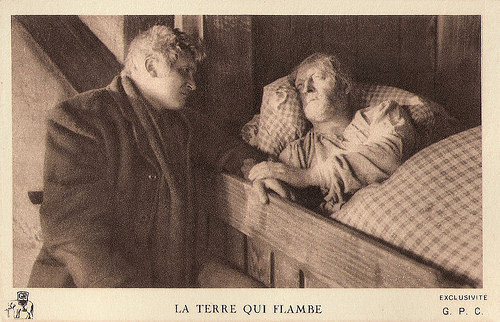
French postcard by Edition de la Cinématographie Française, Paris. Photo: G.P.C. Publicity still for Der brennende Acker/Burning Soil/La terre qui flambe (Friedrich Wilhelm Murnau, 1922).
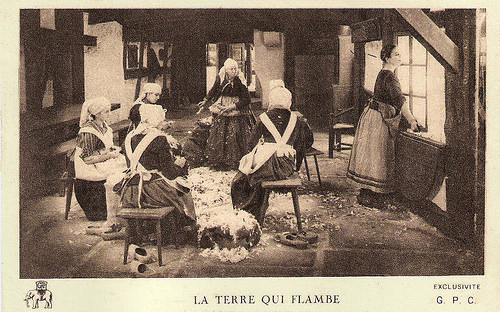
French postcard by Edition de la Cinématographie Française, Paris. Photo: G.P.C. Publicity still for Der brennende Acker/Burning Soil/La terre qui flambe (Friedrich Wilhelm Murnau, 1922).
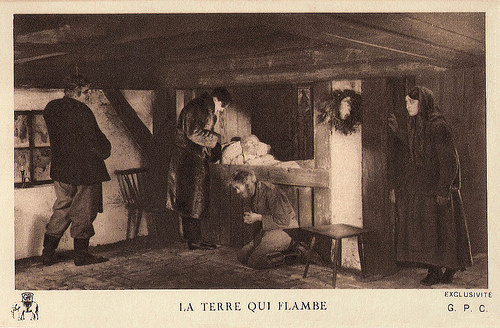
French postcard by Edition de la Cinématographie Française, Paris. Photo: G.P.C. Publicity still for Der brennende Acker/Burning Soil/La terre qui flambe (Friedrich Wilhelm Murnau, 1922).
The Devil's Field
Der brennende Acker presents two households: that of the wealthy Count Josef Emmanuel of Rudenbergand the Rogs, a fairly prosperous farm family who live nearby.
When the old farmer Rog ( Werner Krauss ) dies, his hard-working son Peter (Eugen Klöpfer) attends him and stays at the farm after his father's death.
The other, younger son is the more worldly Johannes ( Vladimir Gajdarov ). He has great ambitions and he refuses the love of the servant Maria (Grete Diercks).
His ambition leads the handsome Johannes to charm Gerda ( Lya de Putti ), the daughter of the old Count Rudenberg (Eduard von Winterstein), who is also dying. Gerda helps Johannes to a job as the secretary of the Count.
Johannes discovers that the Count's second wife Helga (Stella Arbenina) will inherit the Devil's Field. Only he knows that the land sits on an untapped oil field worth a fortune.
Joahnnes turns his attention from Gerda to Helga. When she is widowed, he marries her. His greed leads to death and burning soil.
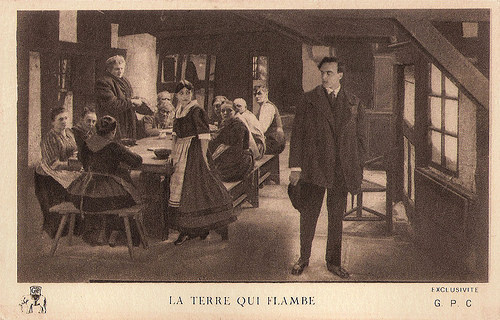
French postcard by Edition de la Cinématographie Française, Paris. Photo: G.P.C. Publicity still for Der brennende Acker/Burning Soil/La terre qui flambe (Friedrich Wilhelm Murnau, 1922).
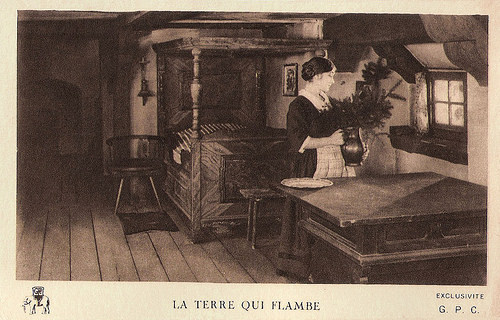
French postcard by Edition de la Cinématographie Française, Paris. Photo: G.P.C. Publicity still for Der brennende Acker/Burning Soil/La terre qui flambe (Friedrich Wilhelm Murnau, 1922).
Friedrich Wilhelm Murnau
In the 1920s Friedrich Wilhelm Murnau (1888-1931) was with Fritz Lang and G. W. Pabst one of the three great German film directors and Sandra Brennan at AllMovie writes that "To this day German filmmaker F.W.Murnau remains one of the most influential directors of cinema."
He made his directorial debut in 1919, the fantasy film Der Knabe in Blau/Emerald of Death (1919). His next films were also fantasy films: The three-part Satanas/Satan (1919), Murnau's first film with cinematographer Karl Freund and leading actor Conrad Veidt , and Der Bucklige und die Tänzerin/The Hunchback and the Dancer (1920), that marked the start of Murnau's collaboration with screenplay writer Carl Mayer.
With Schloss Vogelöd/The Haunted Castle (1921), filmed in only 16 days, Murnau already proved his ability to create an atmosphere of fear and horror, an ability that he masterly refined in Der Brennende Acker (1922) and his famous vampire film Nosferatu – Eine Symphonie des Grauens/Nosferatu, a Symphony of Horror (1922).
His next film, Der letzte Mann/The Last Laugh (1924), utilized unique camera techniques that later became the basis for mise-en-scene. For this film, Karl Freund masterly operated the 'moving camera'.
Besides Der letzte Mann, Murnau's literary adaptations Tartüff/Tartuffe (1925) and Faust (1925/26) also rank among the classic films of Weimar cinema produced by Erich Pommer.
In 1926, Murnau moved to Hollywood to work for Fox studios. His first American film, Sunrise: A Story of Two Humans (1927), is considered to be the apex of German silent cinema, and won an Academy award for its artistic quality.
His next film Four Devils (1928) was turned into a happy ending and was equipped with a sound track. The same happened to Our Daily Bread/City Girl (1929/30).
Murnau returned to Berlin but his negotiations with Ufa did not lead to a result. In 1929, he travelled to Tahiti where he made the naïve love story Tabu (1931) at his own expense. Deep in debt, he returned to Hollywood, where Paramount offered him a ten-year contract.
Tabu became a box-office hit, but the week before it opened, F.W. Murnau was killed in an auto accident. He was only 42.
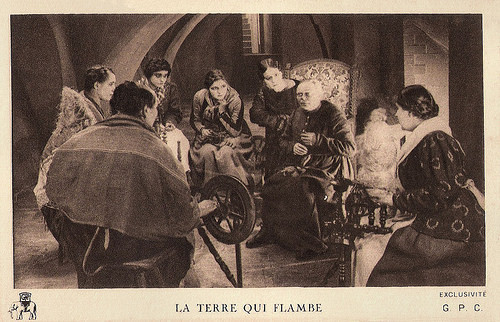
French postcard by Edition de la Cinématographie Française, Paris. Photo: G.P.C. Publicity still for Der brennende Acker/Burning Soil/La terre qui flambe (Friedrich Wilhelm Murnau, 1922).
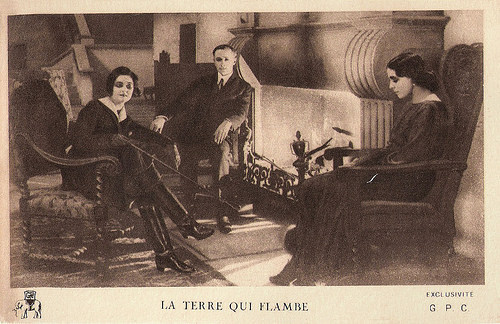
French postcard by Edition de la Cinématographie Française, Paris. Photo: G.P.C. Publicity still for Der brennende Acker/Burning Soil/La terre qui flambe (Friedrich Wilhelm Murnau, 1922).
Der brennende Acker
Der brennende Acker/Burning Soil or in French La terre qui flambe was considered lost for a long time. In 1978 an almost complete print was found in the estate of an Italian priest, who had organised screenings with his film collection in mental hospitals
Since then, Der brennende Acker is acclaimed for its visual quality, the contrast between the simple rustic farm and the airy and elegant castle. Thorkell A. Ottarsson at IMDb : "The film is quite dramatic and dark, even surprisingly dark at times. A superb film from one of the best directors of all time."
To achieve his visual effects, innovative camera angles, and bold lighting, Murnau had two of the most renowned cameramen photographing the film. Fritz Arno Wagner filmed the first part and Karl Freund the second part, and the sets were built by the equally renowned Rochus Gliese.
Karl Freund, who began as a projectionist in Berlin and newsreel cameraman, worked for Ufa in the 1920s and gained the international reputation of being a master cameraman. His later credits include such classics as Metropolis, Der Lezte Mann/The Last Laugh, Der Golem/The Golem and Variété/Variety.
W. Morrow at IMDb describes beautifully his fascination for Der brennende Acker: "a sustained mood of wintry melancholy, perked by a number of understated but impressive directorial touches. There's business involving a document torn into little pieces that is poetic. When Murnau was at his peak, in such films as Faust and Sunrise, he would stage his effects on a much grander scale, but here he manages to create a beautiful moment with a few torn pieces of paper."
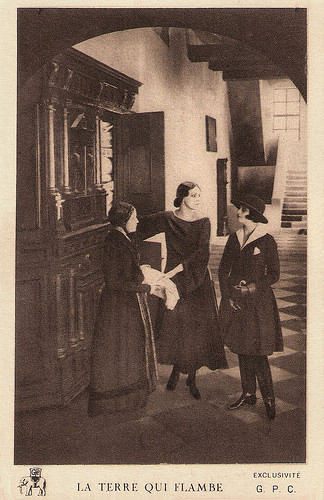
French postcard by Edition de la Cinématographie Française, Paris. Photo: G.P.C. Publicity still for Der brennende Acker/Burning Soil/La terre qui flambe (Friedrich Wilhelm Murnau, 1922).
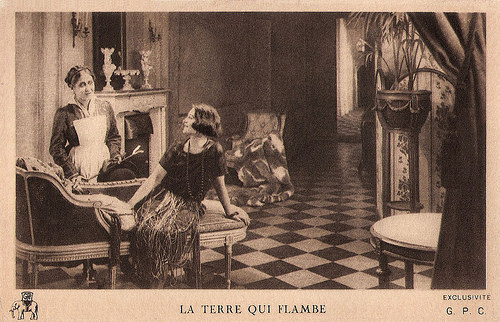
French postcard by Edition de la Cinématographie Française, Paris. Photo: G.P.C. Publicity still for Der brennende Acker/Burning Soil/La terre qui flambe (Friedrich Wilhelm Murnau, 1922).
Sources: Sandra Brennan (AllMovie), John DeBartolo (Silents are Golden), W. Morrow (IMDb), Thorkell A. Ottarsson (IMDb), Yepok (IMDb), Filmportal.de (German), Wikipedia (German) and IMDb.

French postcard by Edition de la Cinématographie Française, Paris. Photo: G.P.C. Publicity still for Der brennende Acker/Burning Soil/La terre qui flambe (Friedrich Wilhelm Murnau, 1922).

French postcard by Edition de la Cinématographie Française, Paris. Photo: G.P.C. Publicity still for Der brennende Acker/Burning Soil/La terre qui flambe (Friedrich Wilhelm Murnau, 1922).

French postcard by Edition de la Cinématographie Française, Paris. Photo: G.P.C. Publicity still for Der brennende Acker/Burning Soil/La terre qui flambe (Friedrich Wilhelm Murnau, 1922).
The Devil's Field
Der brennende Acker presents two households: that of the wealthy Count Josef Emmanuel of Rudenbergand the Rogs, a fairly prosperous farm family who live nearby.
When the old farmer Rog ( Werner Krauss ) dies, his hard-working son Peter (Eugen Klöpfer) attends him and stays at the farm after his father's death.
The other, younger son is the more worldly Johannes ( Vladimir Gajdarov ). He has great ambitions and he refuses the love of the servant Maria (Grete Diercks).
His ambition leads the handsome Johannes to charm Gerda ( Lya de Putti ), the daughter of the old Count Rudenberg (Eduard von Winterstein), who is also dying. Gerda helps Johannes to a job as the secretary of the Count.
Johannes discovers that the Count's second wife Helga (Stella Arbenina) will inherit the Devil's Field. Only he knows that the land sits on an untapped oil field worth a fortune.
Joahnnes turns his attention from Gerda to Helga. When she is widowed, he marries her. His greed leads to death and burning soil.

French postcard by Edition de la Cinématographie Française, Paris. Photo: G.P.C. Publicity still for Der brennende Acker/Burning Soil/La terre qui flambe (Friedrich Wilhelm Murnau, 1922).

French postcard by Edition de la Cinématographie Française, Paris. Photo: G.P.C. Publicity still for Der brennende Acker/Burning Soil/La terre qui flambe (Friedrich Wilhelm Murnau, 1922).
Friedrich Wilhelm Murnau
In the 1920s Friedrich Wilhelm Murnau (1888-1931) was with Fritz Lang and G. W. Pabst one of the three great German film directors and Sandra Brennan at AllMovie writes that "To this day German filmmaker F.W.Murnau remains one of the most influential directors of cinema."
He made his directorial debut in 1919, the fantasy film Der Knabe in Blau/Emerald of Death (1919). His next films were also fantasy films: The three-part Satanas/Satan (1919), Murnau's first film with cinematographer Karl Freund and leading actor Conrad Veidt , and Der Bucklige und die Tänzerin/The Hunchback and the Dancer (1920), that marked the start of Murnau's collaboration with screenplay writer Carl Mayer.
With Schloss Vogelöd/The Haunted Castle (1921), filmed in only 16 days, Murnau already proved his ability to create an atmosphere of fear and horror, an ability that he masterly refined in Der Brennende Acker (1922) and his famous vampire film Nosferatu – Eine Symphonie des Grauens/Nosferatu, a Symphony of Horror (1922).
His next film, Der letzte Mann/The Last Laugh (1924), utilized unique camera techniques that later became the basis for mise-en-scene. For this film, Karl Freund masterly operated the 'moving camera'.
Besides Der letzte Mann, Murnau's literary adaptations Tartüff/Tartuffe (1925) and Faust (1925/26) also rank among the classic films of Weimar cinema produced by Erich Pommer.
In 1926, Murnau moved to Hollywood to work for Fox studios. His first American film, Sunrise: A Story of Two Humans (1927), is considered to be the apex of German silent cinema, and won an Academy award for its artistic quality.
His next film Four Devils (1928) was turned into a happy ending and was equipped with a sound track. The same happened to Our Daily Bread/City Girl (1929/30).
Murnau returned to Berlin but his negotiations with Ufa did not lead to a result. In 1929, he travelled to Tahiti where he made the naïve love story Tabu (1931) at his own expense. Deep in debt, he returned to Hollywood, where Paramount offered him a ten-year contract.
Tabu became a box-office hit, but the week before it opened, F.W. Murnau was killed in an auto accident. He was only 42.

French postcard by Edition de la Cinématographie Française, Paris. Photo: G.P.C. Publicity still for Der brennende Acker/Burning Soil/La terre qui flambe (Friedrich Wilhelm Murnau, 1922).

French postcard by Edition de la Cinématographie Française, Paris. Photo: G.P.C. Publicity still for Der brennende Acker/Burning Soil/La terre qui flambe (Friedrich Wilhelm Murnau, 1922).
Der brennende Acker
Der brennende Acker/Burning Soil or in French La terre qui flambe was considered lost for a long time. In 1978 an almost complete print was found in the estate of an Italian priest, who had organised screenings with his film collection in mental hospitals
Since then, Der brennende Acker is acclaimed for its visual quality, the contrast between the simple rustic farm and the airy and elegant castle. Thorkell A. Ottarsson at IMDb : "The film is quite dramatic and dark, even surprisingly dark at times. A superb film from one of the best directors of all time."
To achieve his visual effects, innovative camera angles, and bold lighting, Murnau had two of the most renowned cameramen photographing the film. Fritz Arno Wagner filmed the first part and Karl Freund the second part, and the sets were built by the equally renowned Rochus Gliese.
Karl Freund, who began as a projectionist in Berlin and newsreel cameraman, worked for Ufa in the 1920s and gained the international reputation of being a master cameraman. His later credits include such classics as Metropolis, Der Lezte Mann/The Last Laugh, Der Golem/The Golem and Variété/Variety.
W. Morrow at IMDb describes beautifully his fascination for Der brennende Acker: "a sustained mood of wintry melancholy, perked by a number of understated but impressive directorial touches. There's business involving a document torn into little pieces that is poetic. When Murnau was at his peak, in such films as Faust and Sunrise, he would stage his effects on a much grander scale, but here he manages to create a beautiful moment with a few torn pieces of paper."

French postcard by Edition de la Cinématographie Française, Paris. Photo: G.P.C. Publicity still for Der brennende Acker/Burning Soil/La terre qui flambe (Friedrich Wilhelm Murnau, 1922).

French postcard by Edition de la Cinématographie Française, Paris. Photo: G.P.C. Publicity still for Der brennende Acker/Burning Soil/La terre qui flambe (Friedrich Wilhelm Murnau, 1922).
Sources: Sandra Brennan (AllMovie), John DeBartolo (Silents are Golden), W. Morrow (IMDb), Thorkell A. Ottarsson (IMDb), Yepok (IMDb), Filmportal.de (German), Wikipedia (German) and IMDb.
Published on January 16, 2015 22:00
Paul van Yperen's Blog
- Paul van Yperen's profile
- 13 followers
Paul van Yperen isn't a Goodreads Author
(yet),
but they
do have a blog,
so here are some recent posts imported from
their feed.



